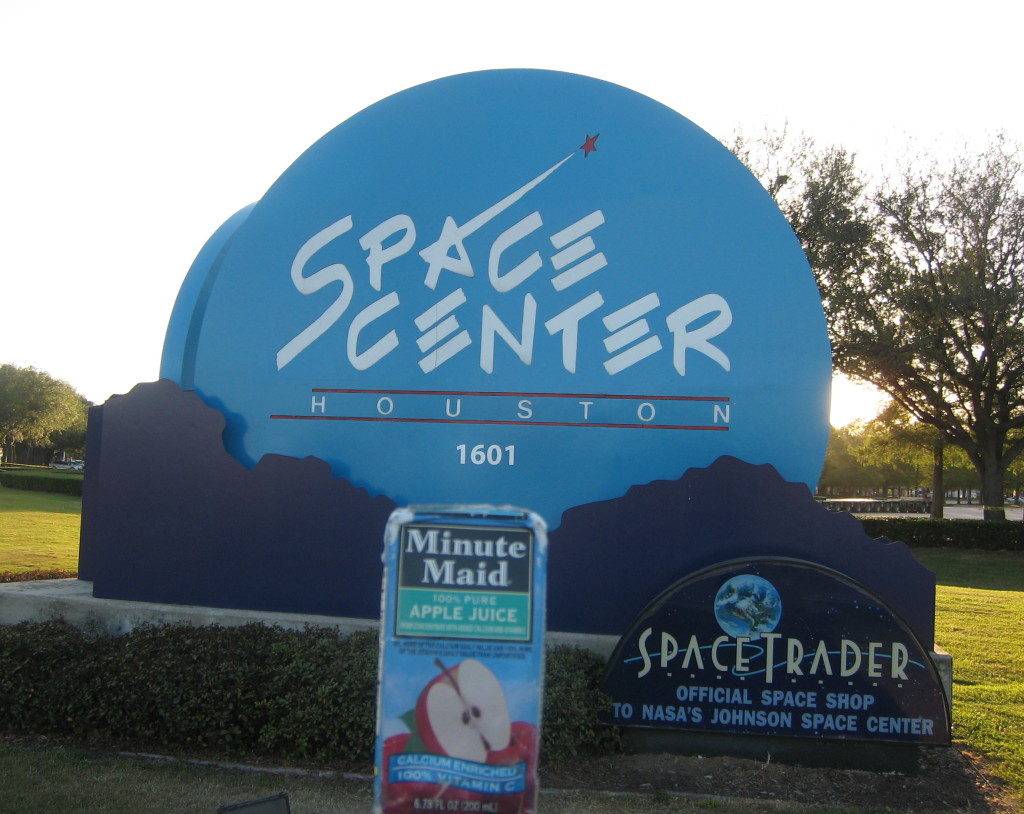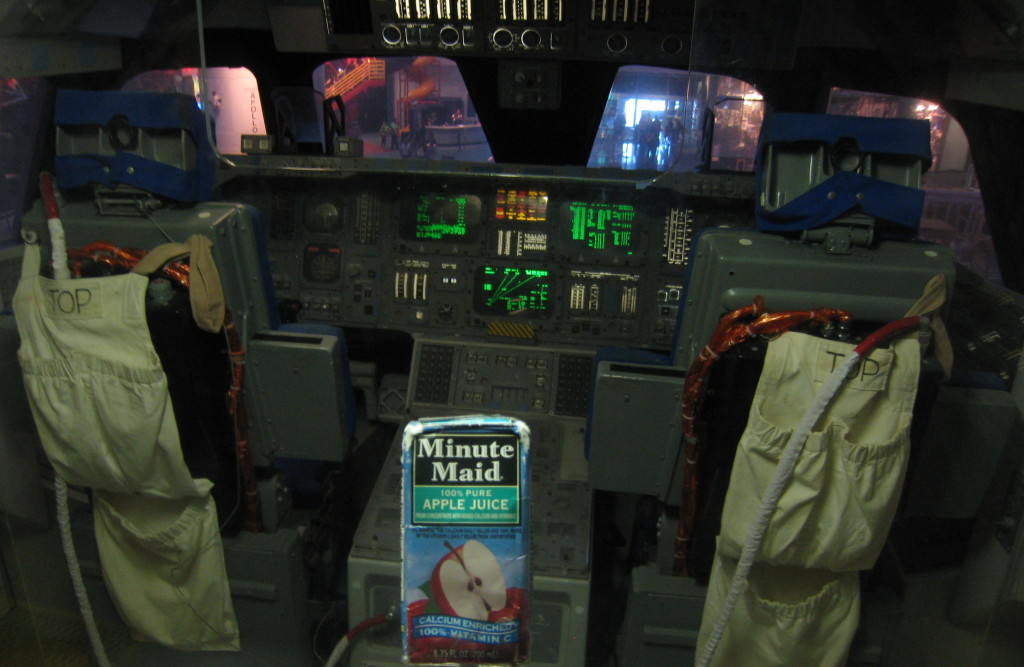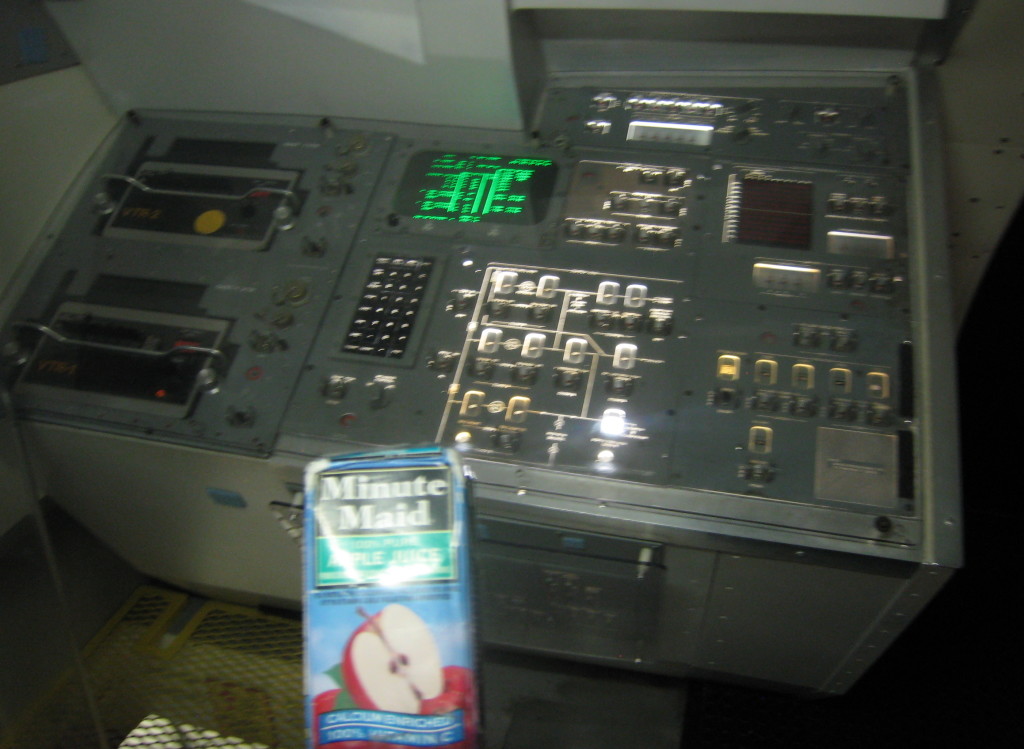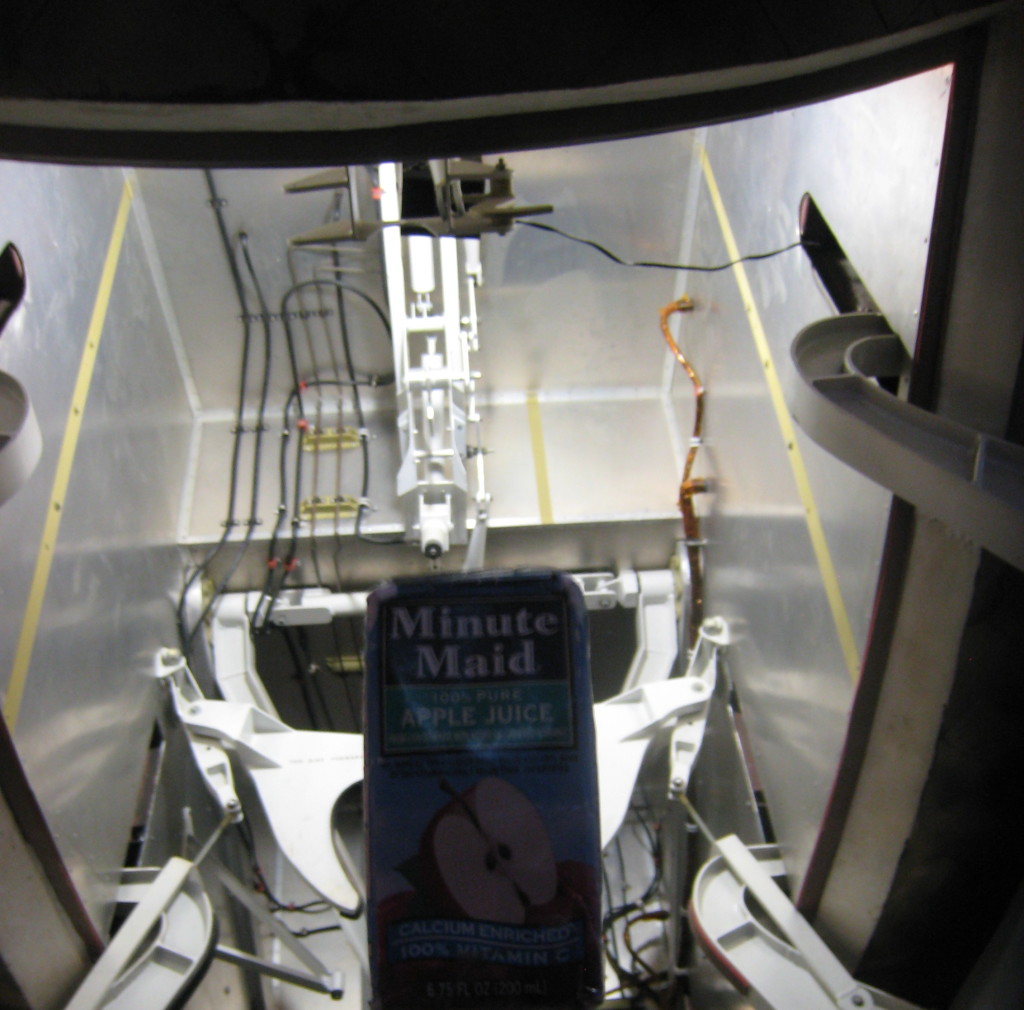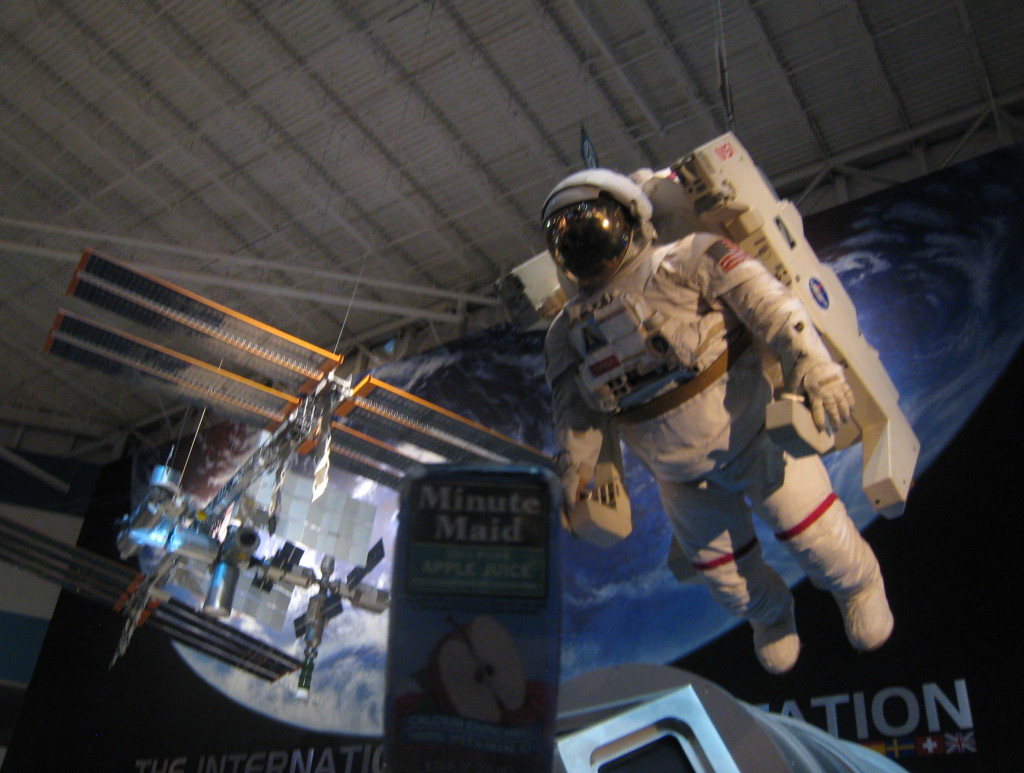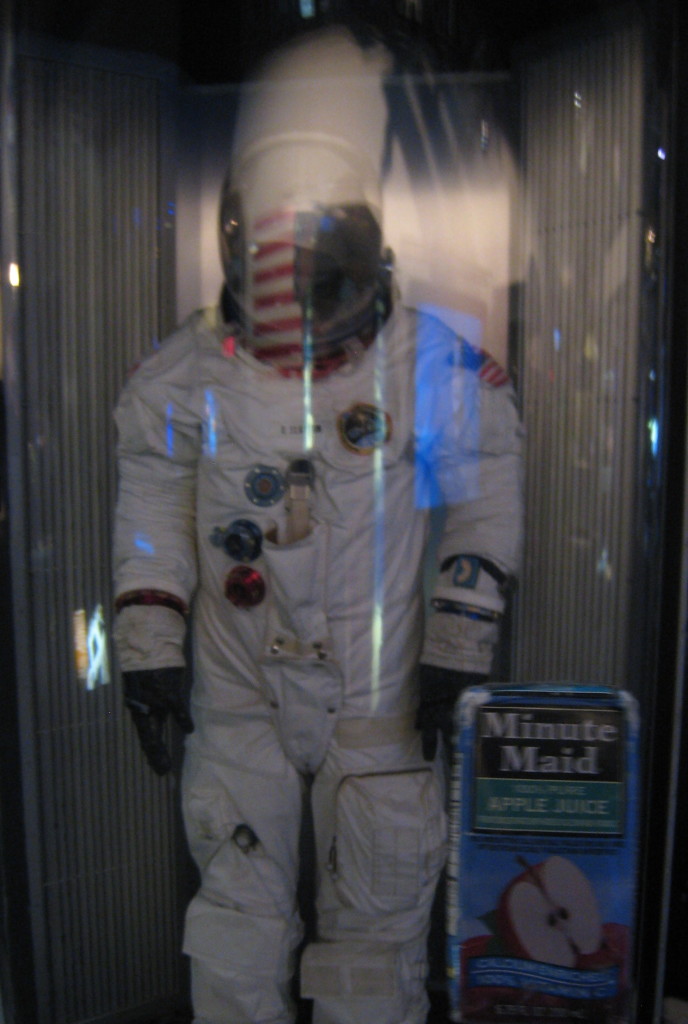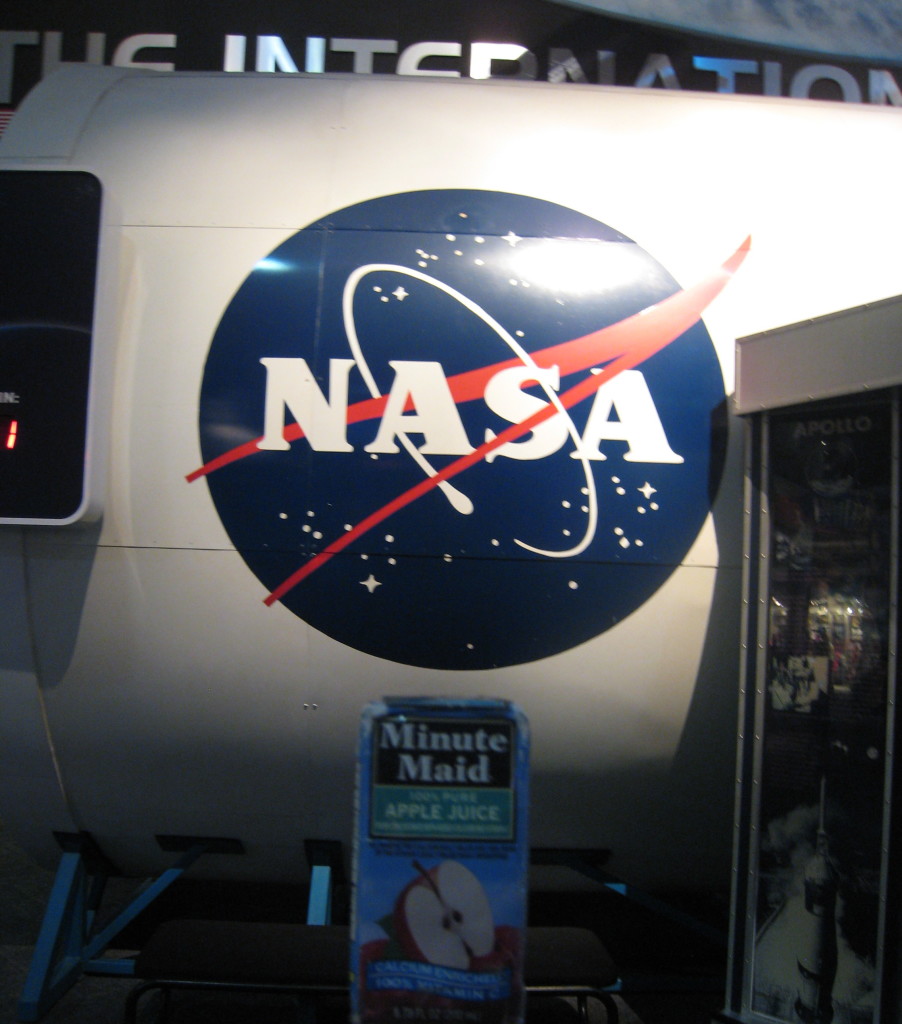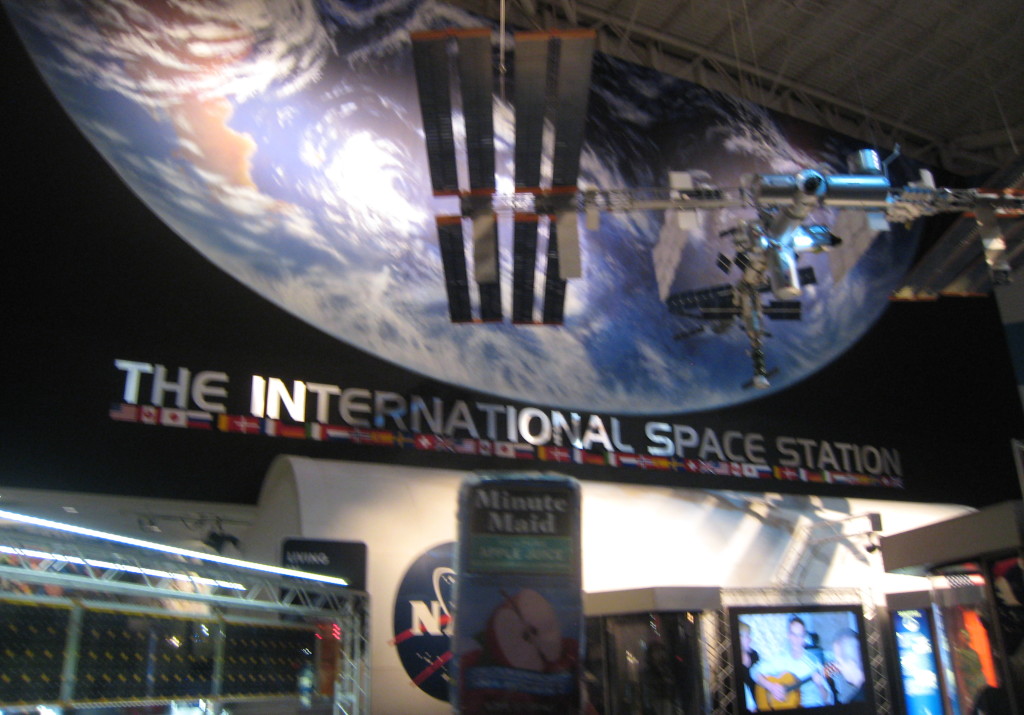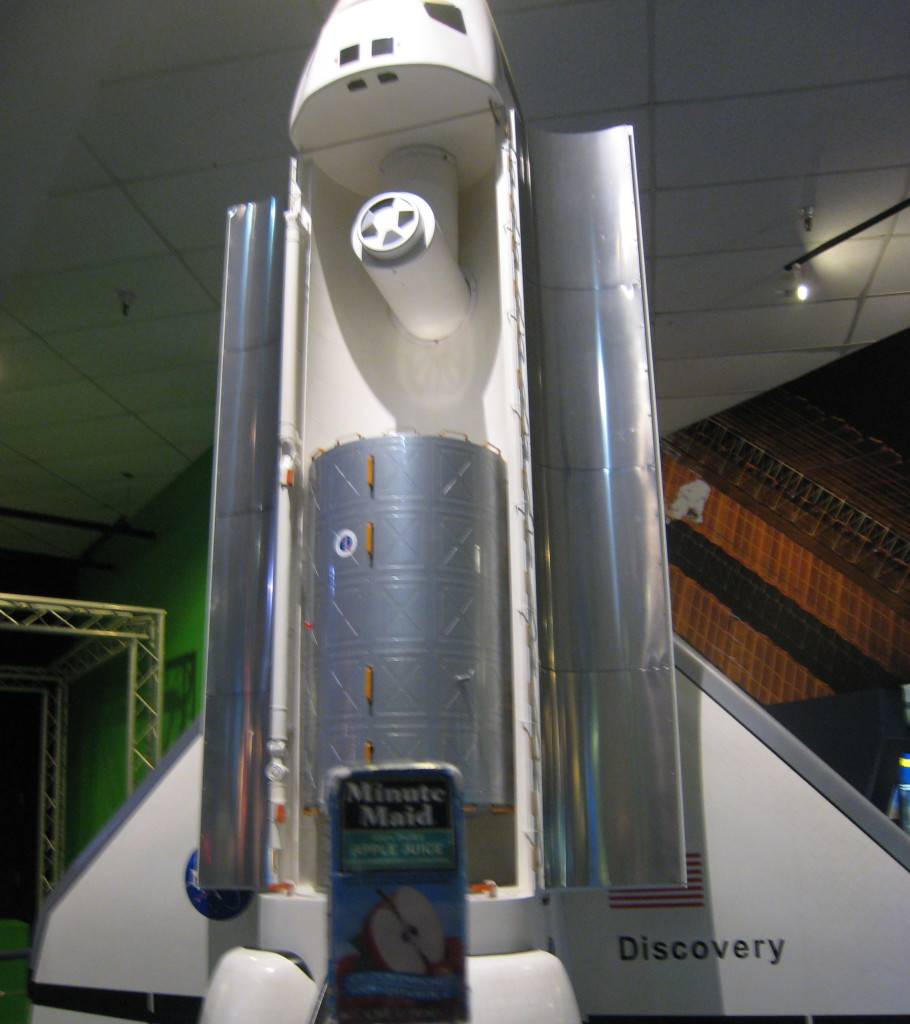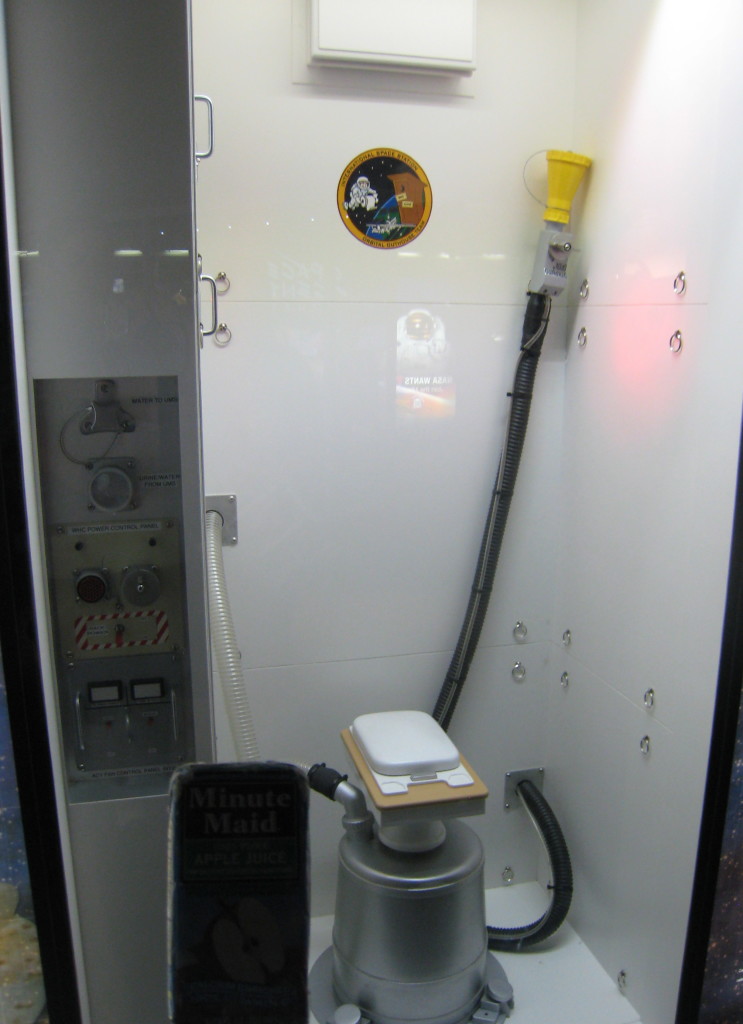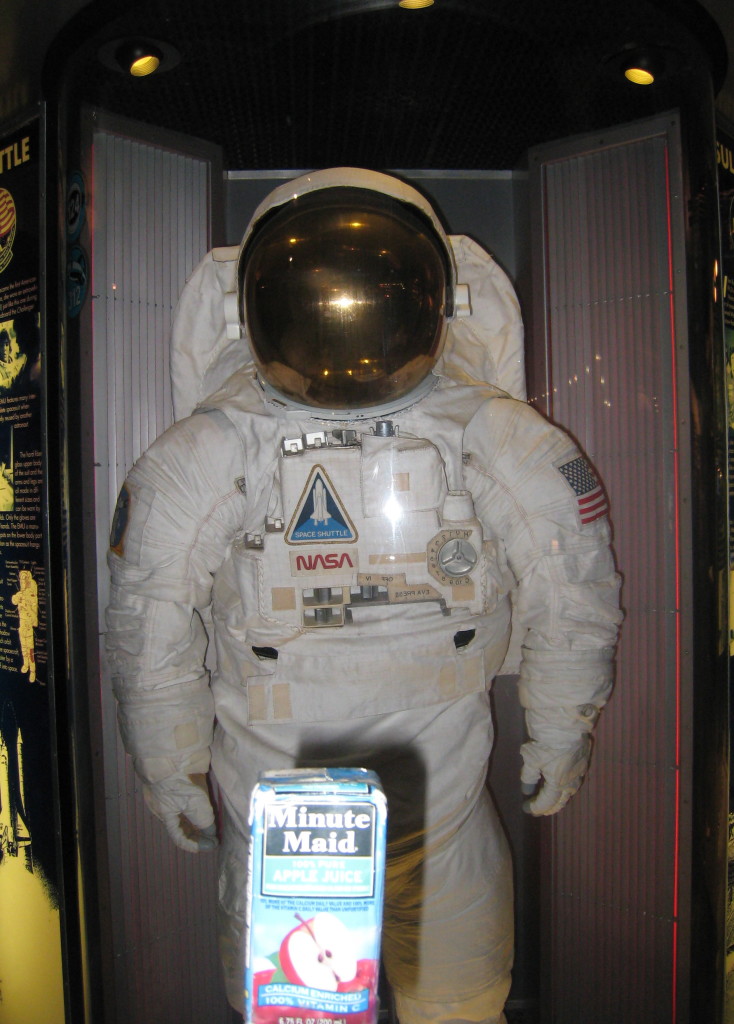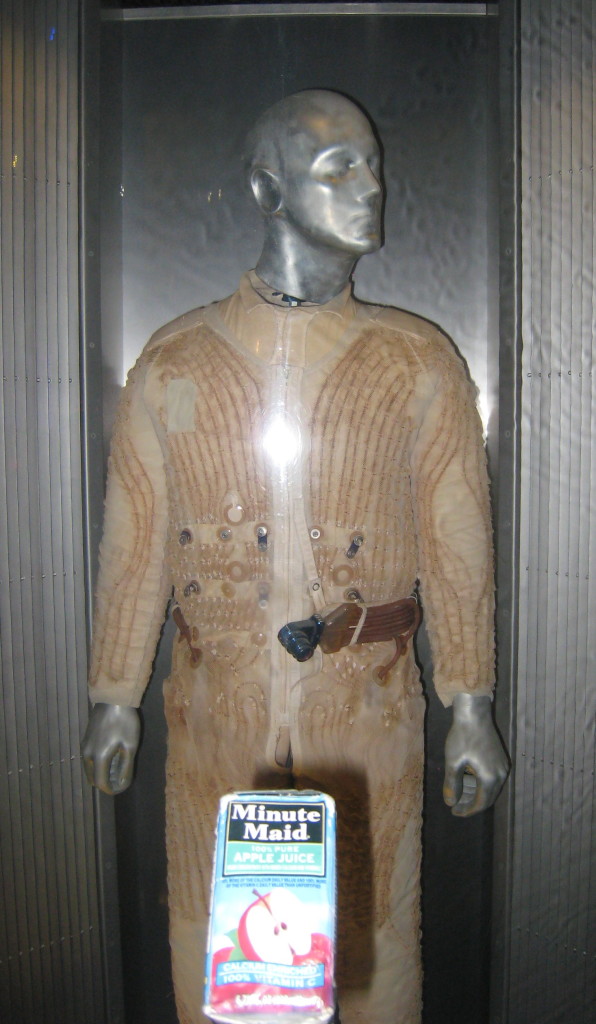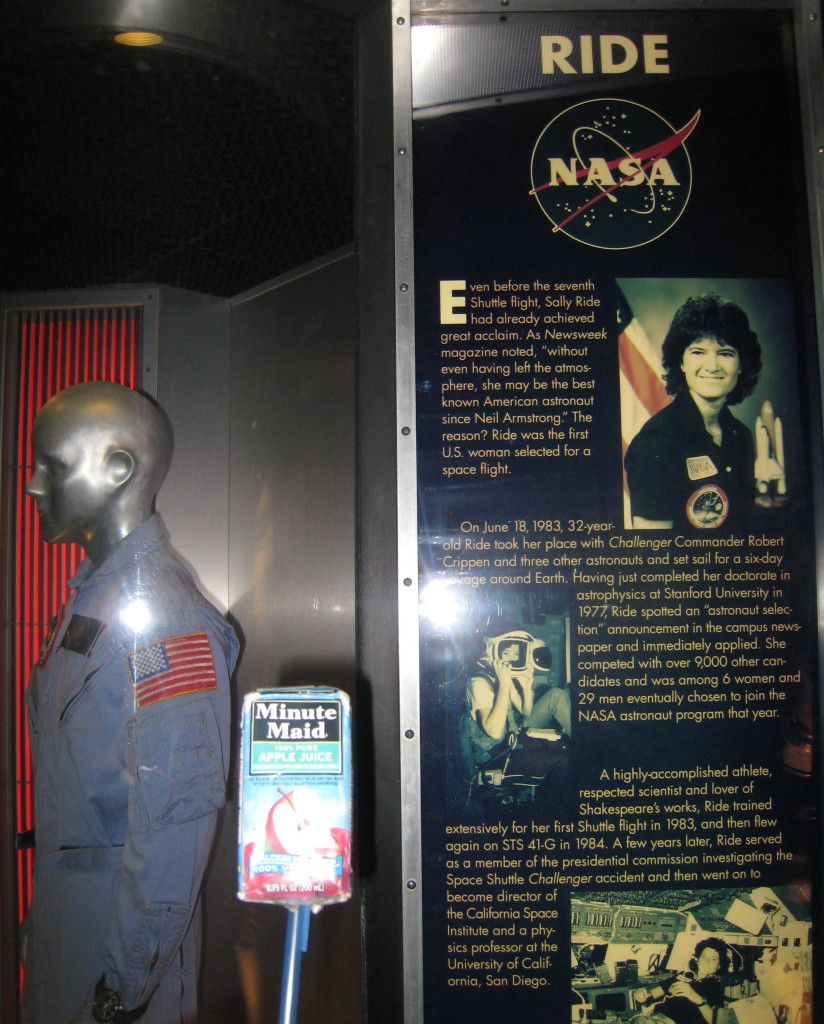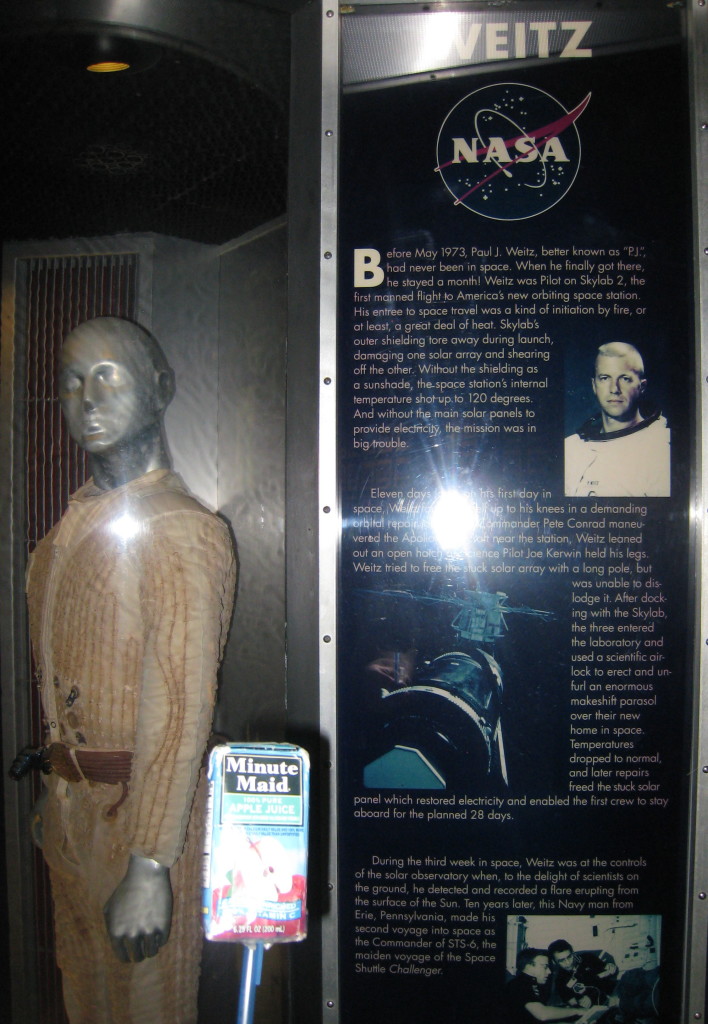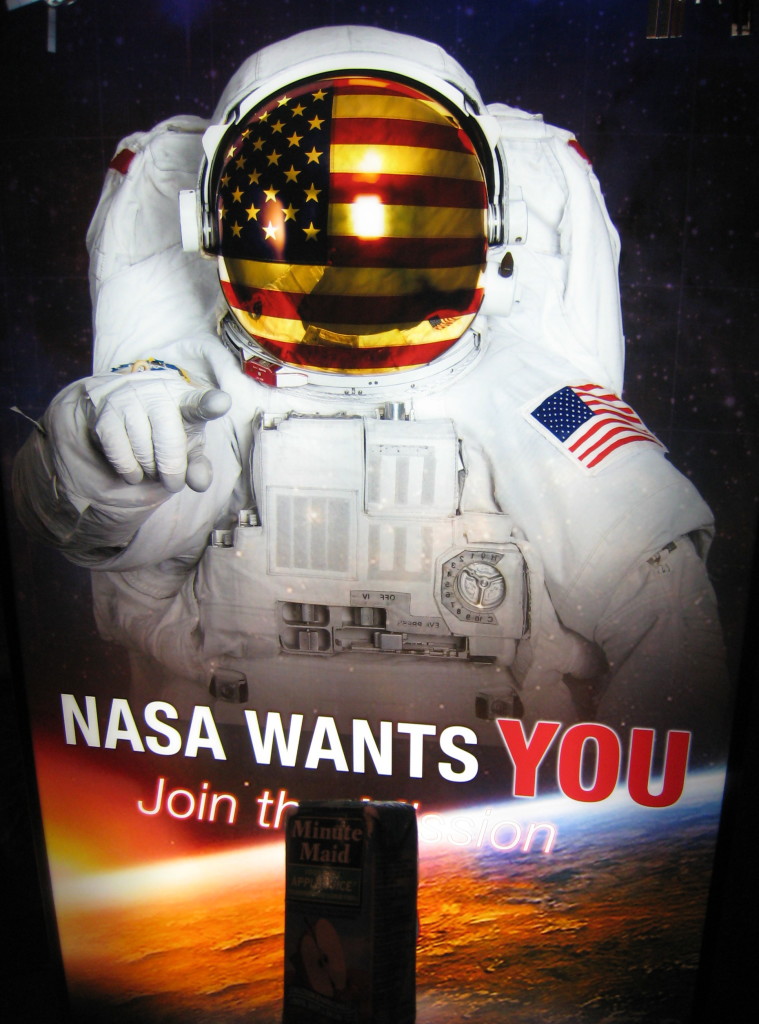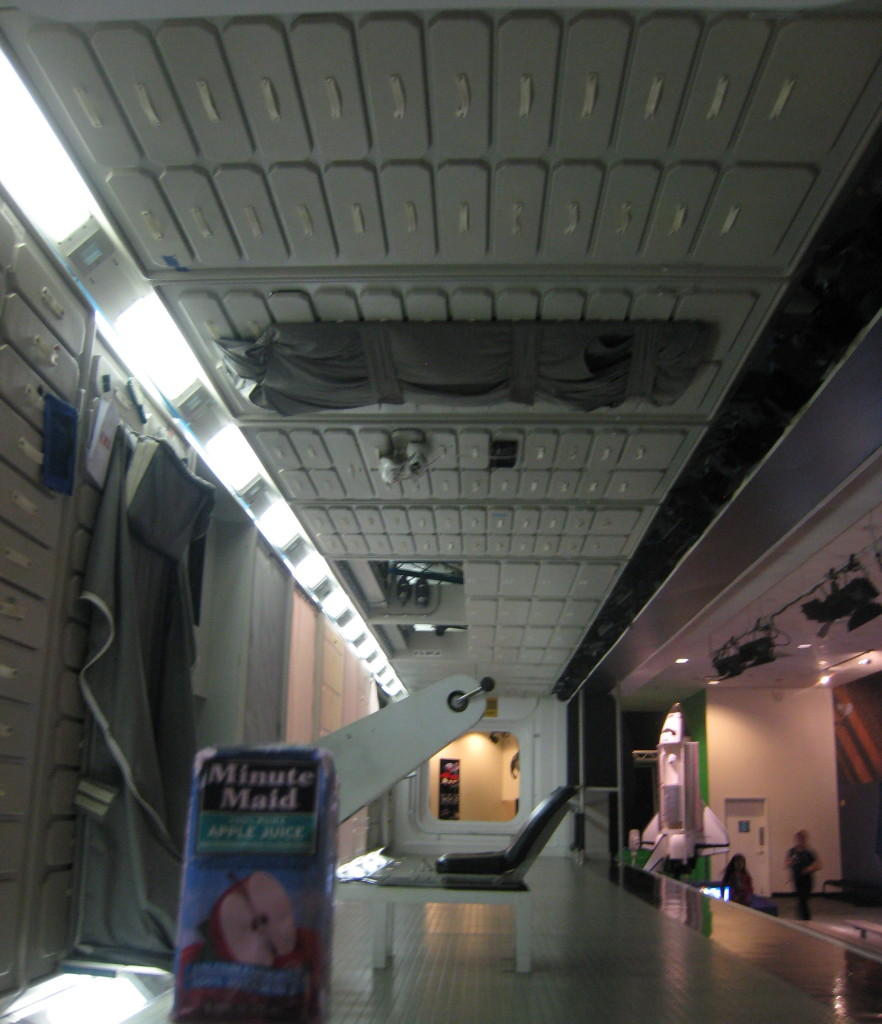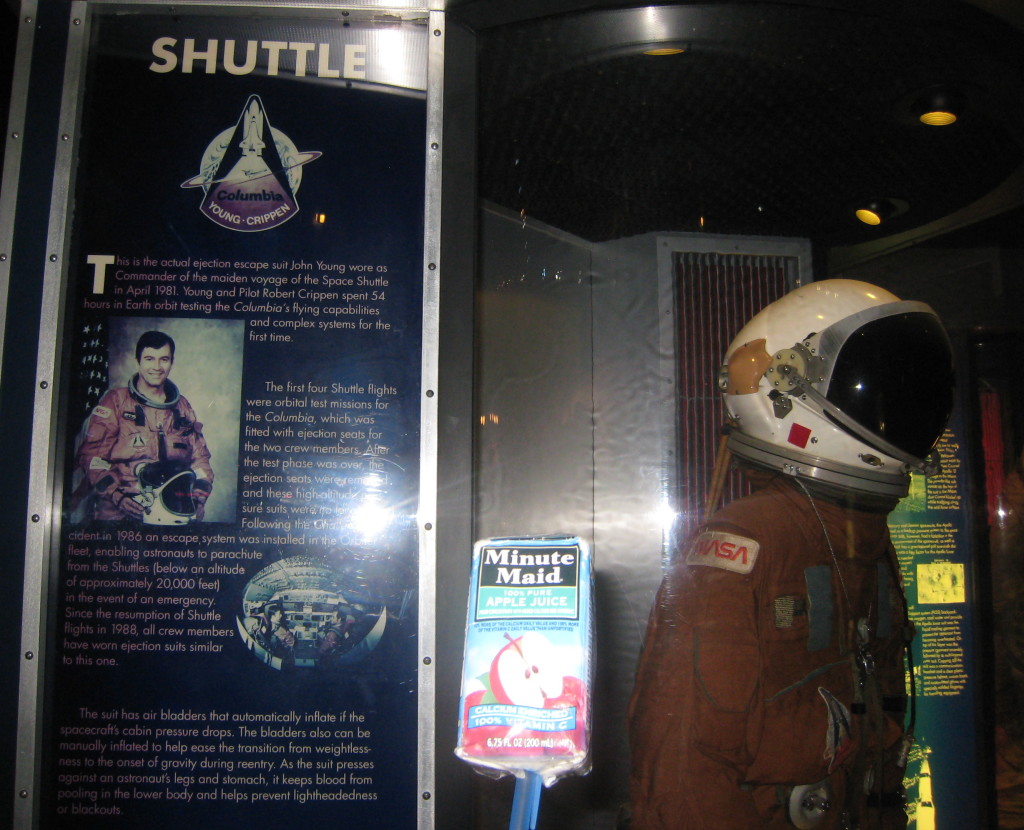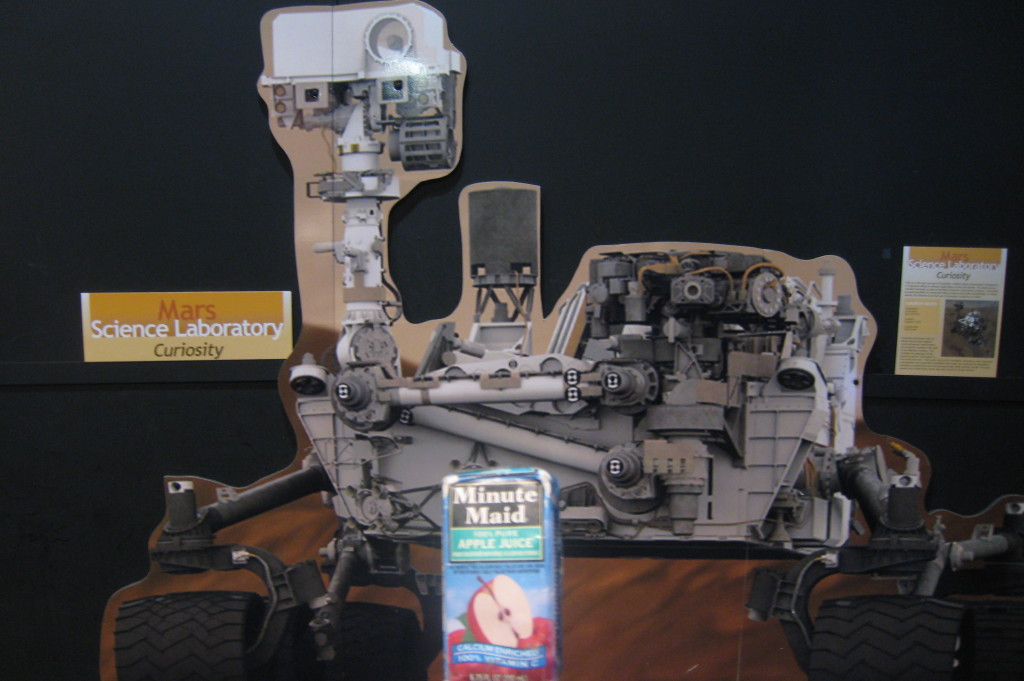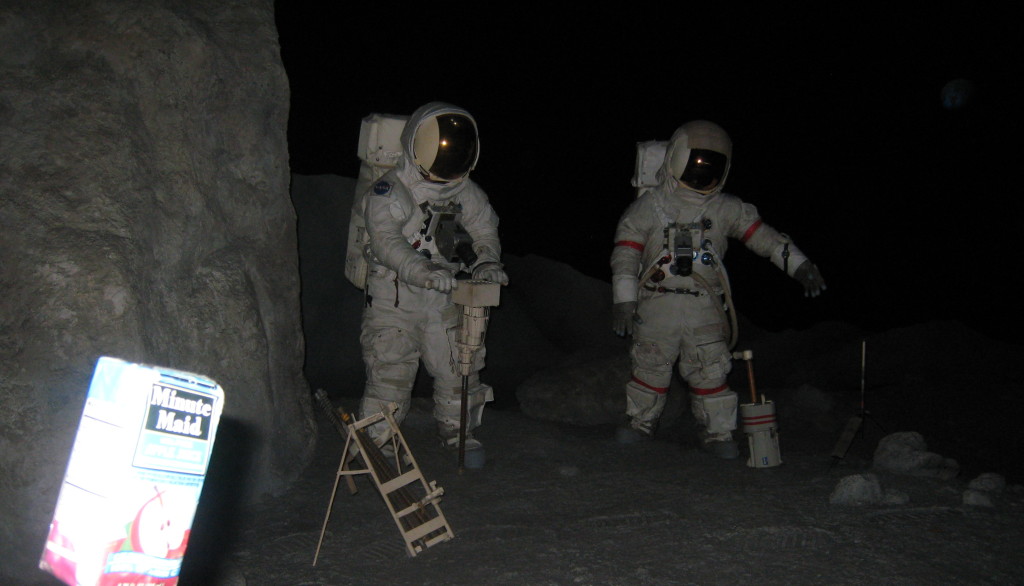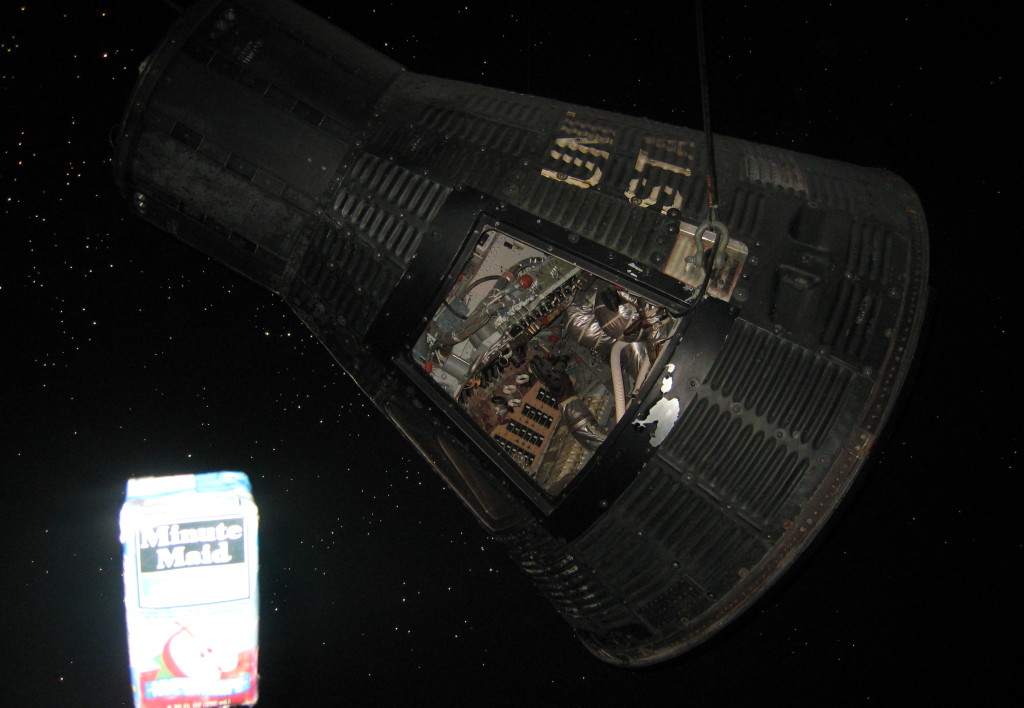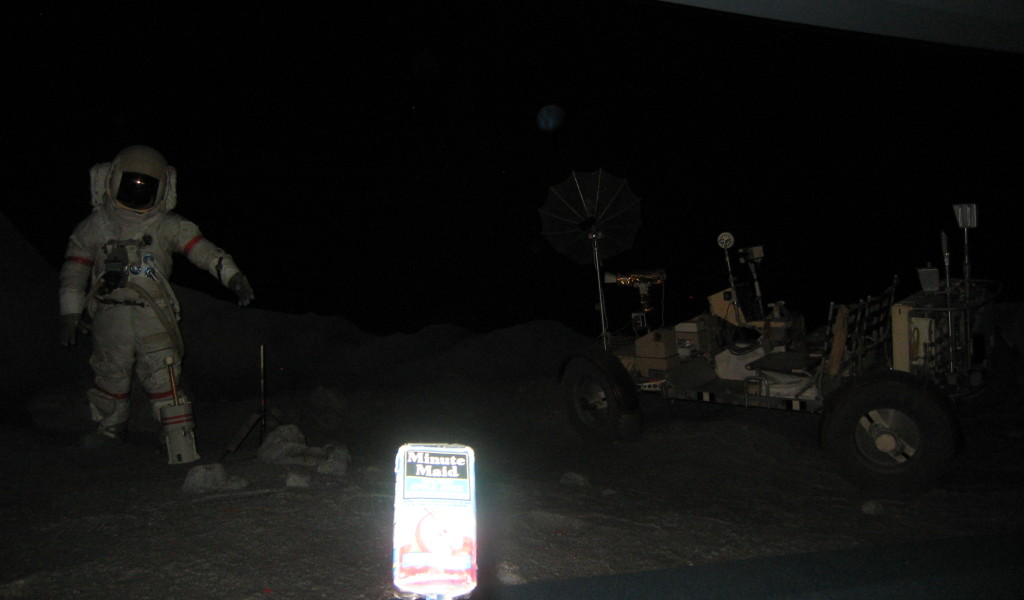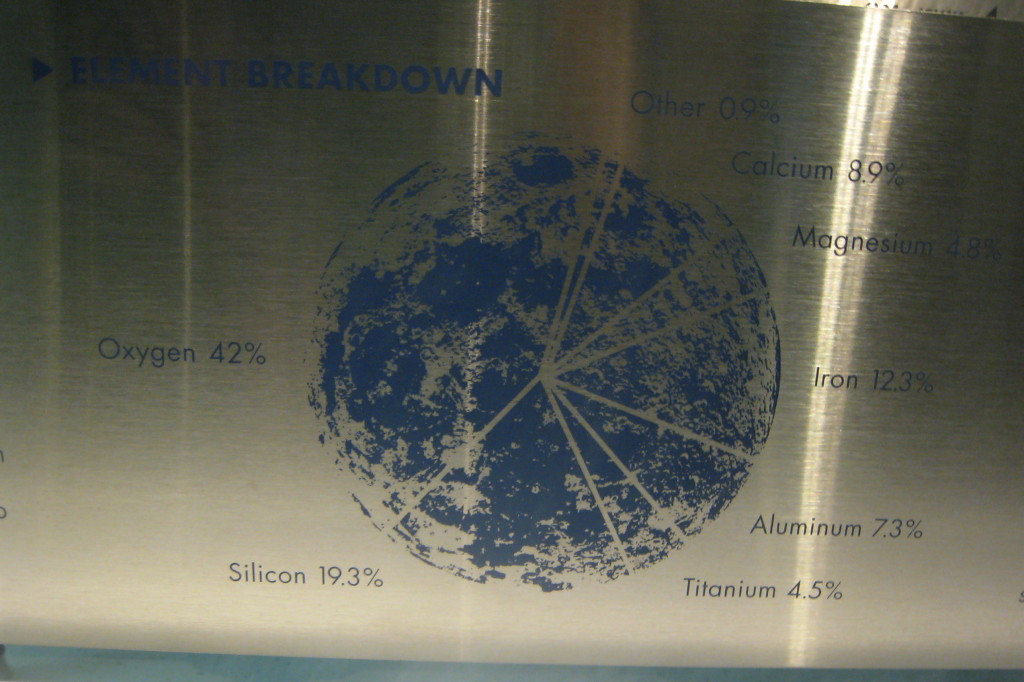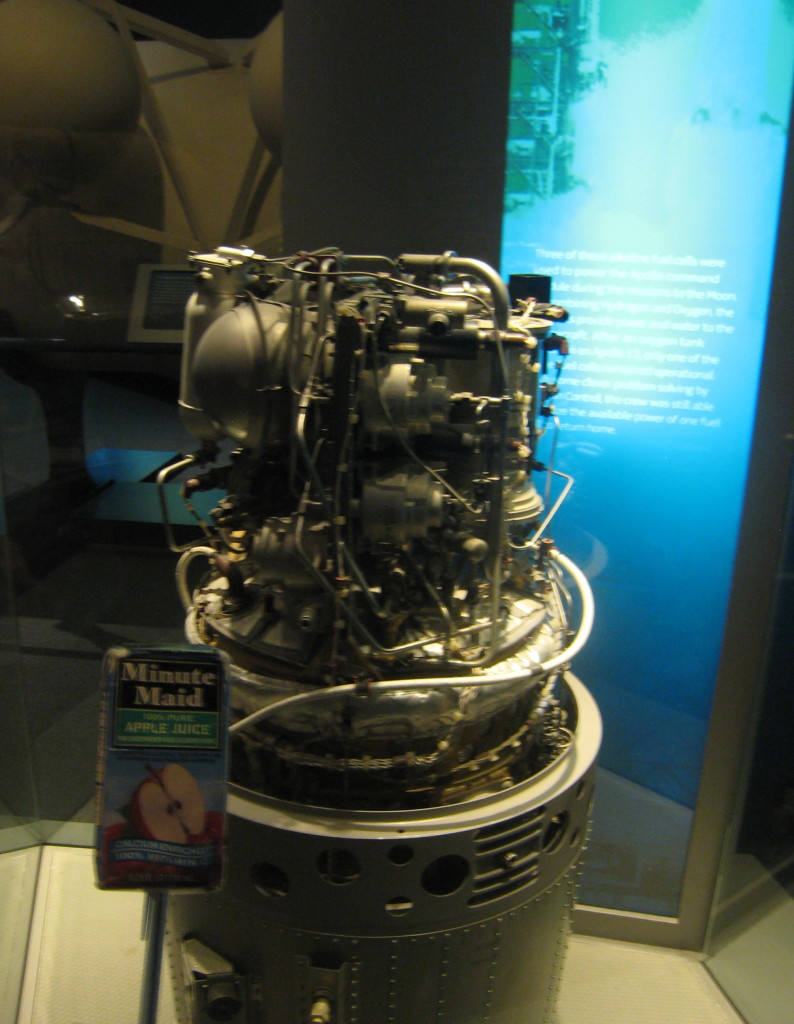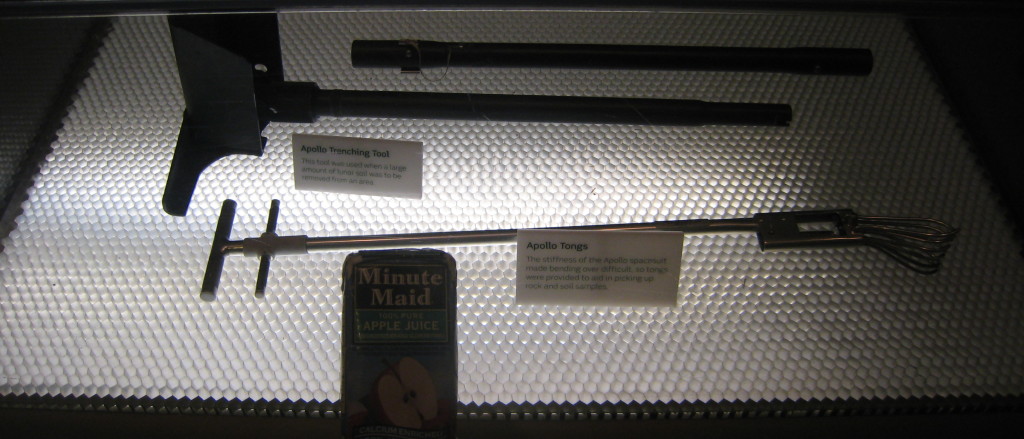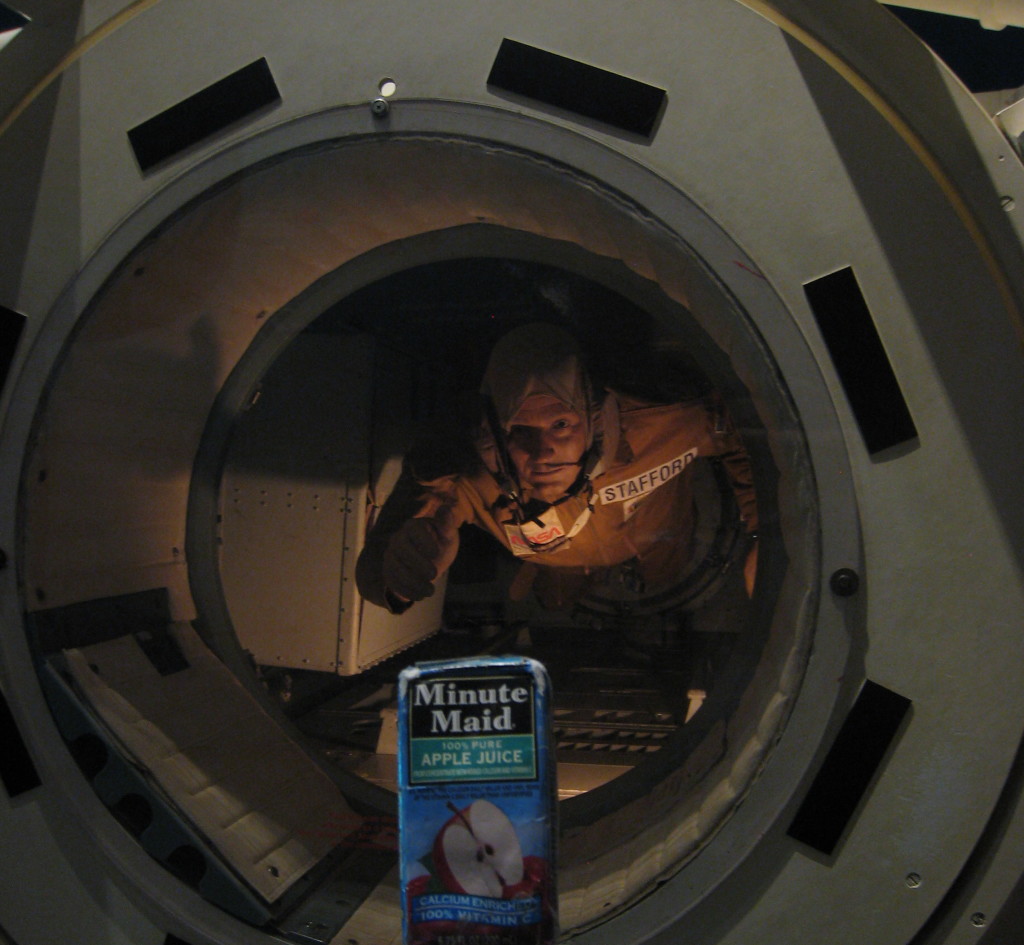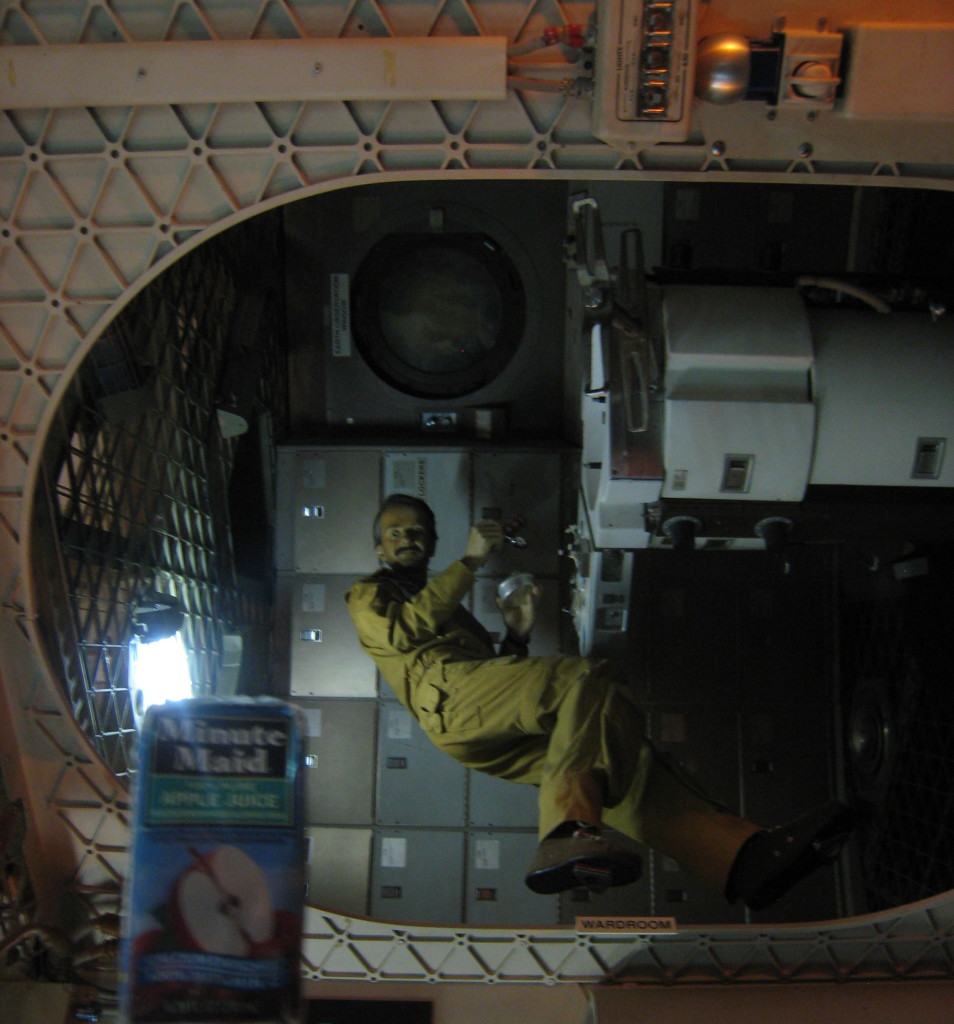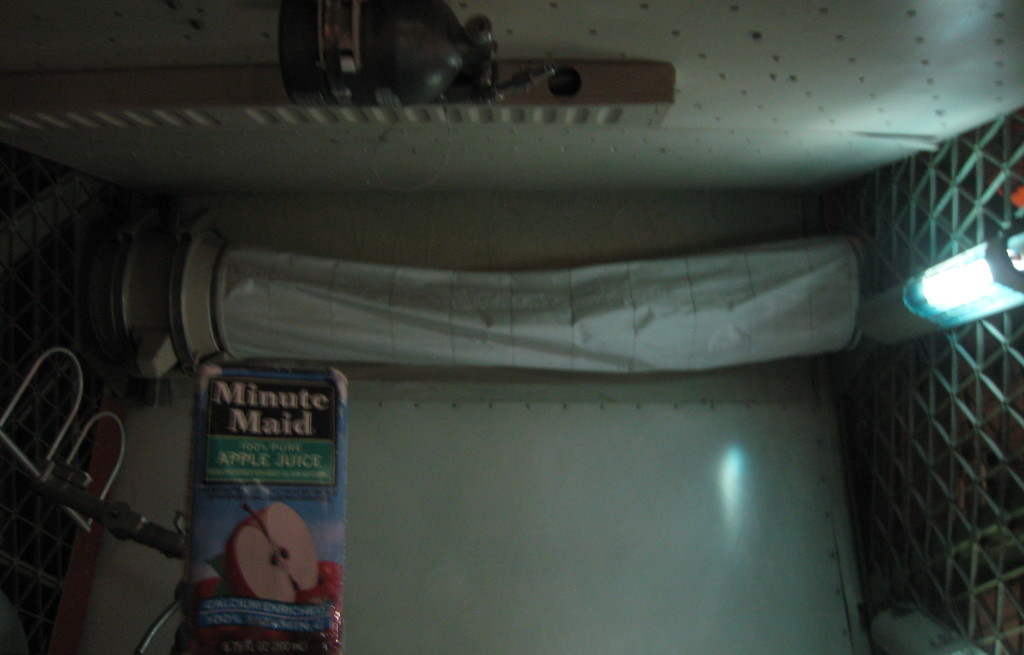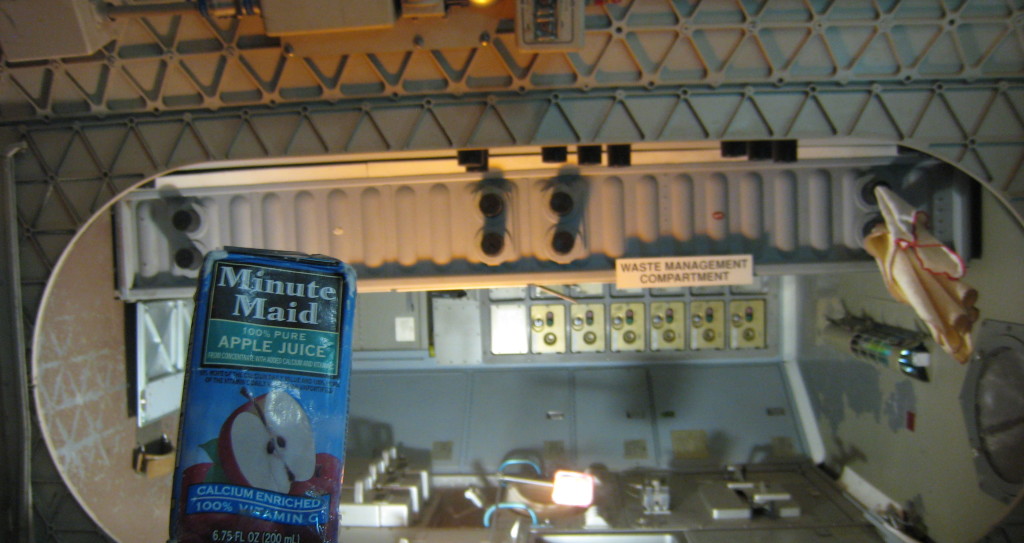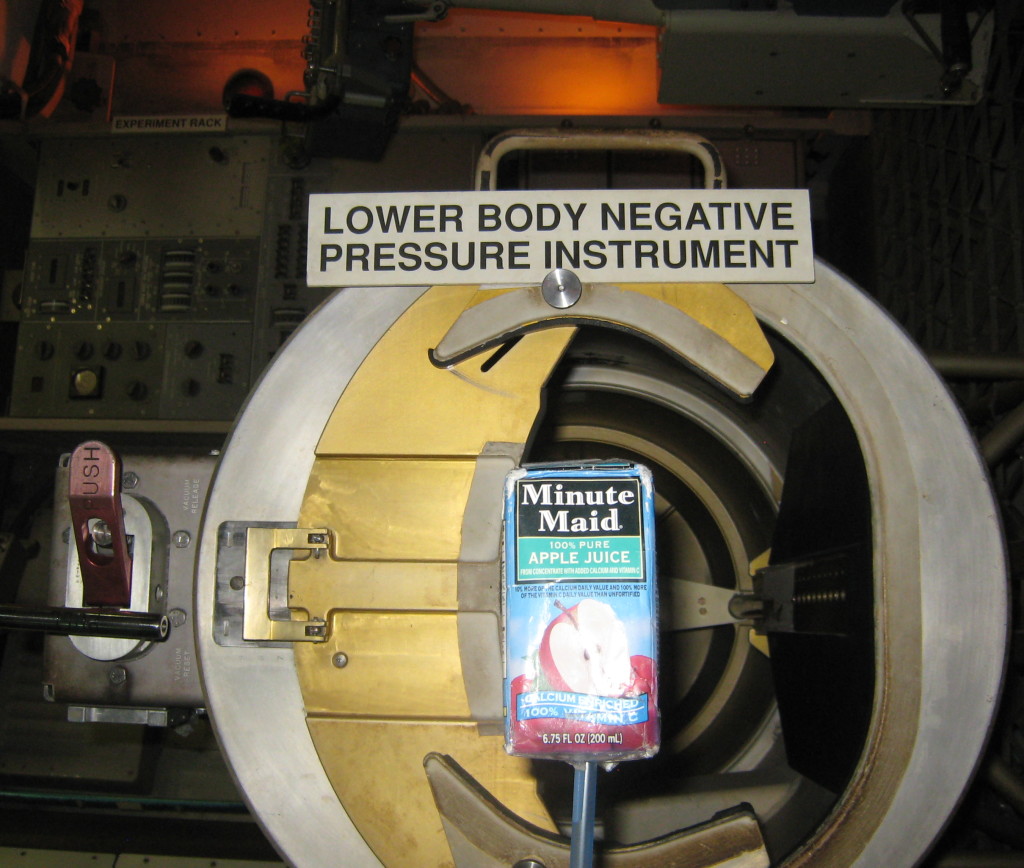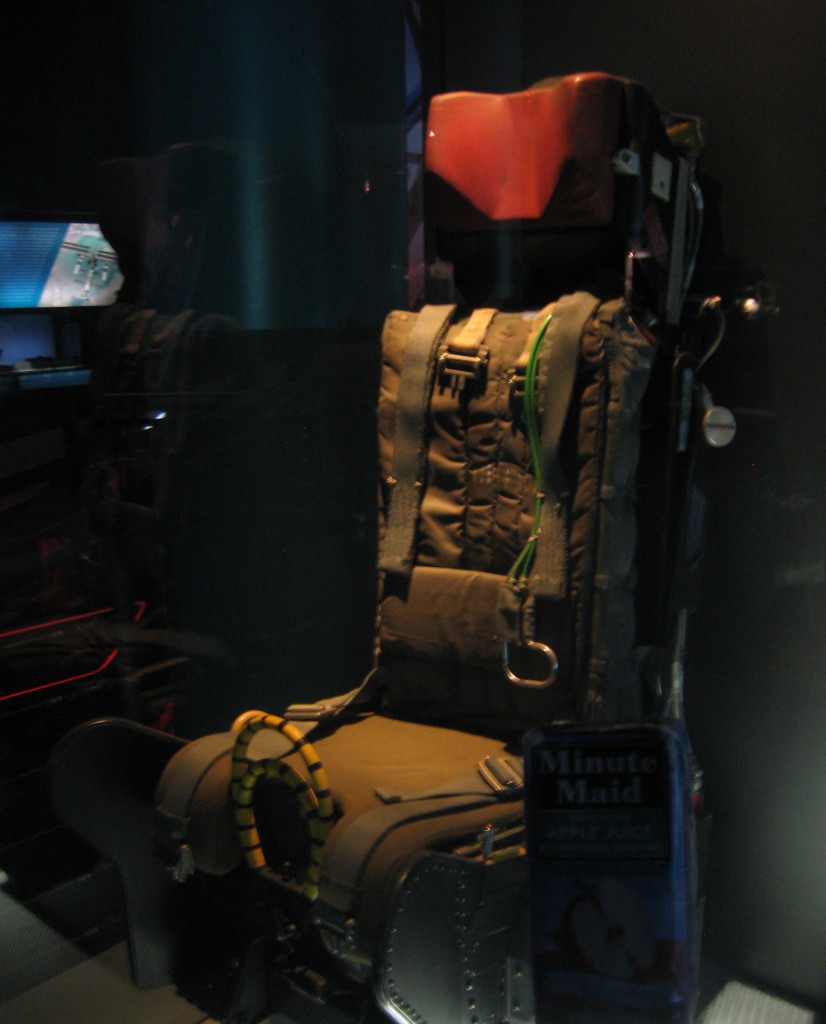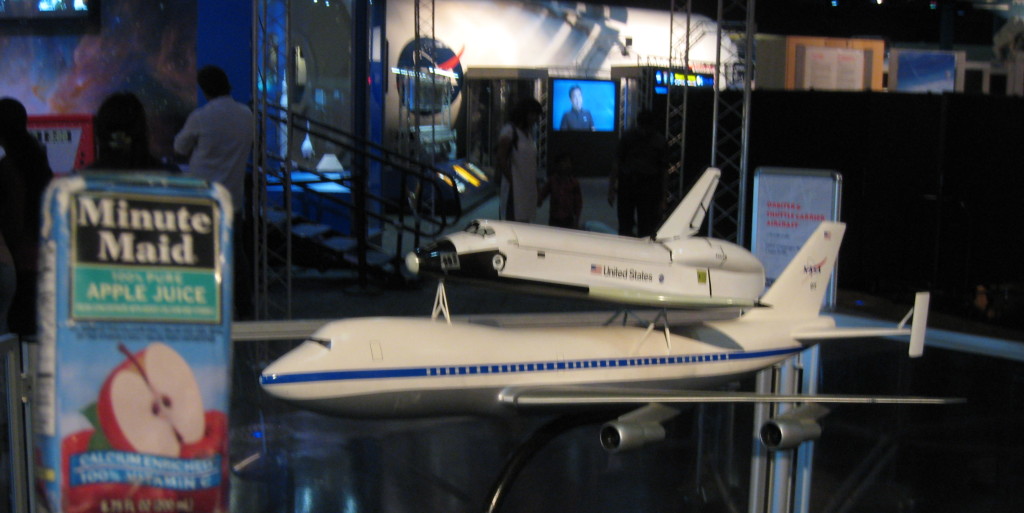Maid Appleton @ Space Center at NASA

“Space Shuttle Main Engine ~ The Space Shuttle Main Engine (SSME) is a liquid fuel engine. It uses liquid oxygen as an oxidizer and liquid hydrogen as a fuel. These two propellants are stored in the External Tank underneath the Orbiter. The oxidizer provides the oxygen that allows the hydrogen to burn as the two propellants combine in the combustion chamber. The exhaust, which exits through the nozzles of the main engines, is water vapor. It is created as the hydrogen and oxygen combine.”

“Space Shuttle Main Engine ~ The Space Shuttle Main Engine (SSME) is the world’s only large reusable rocket engine. Weighing in at about 7000 pounds (3200 k), the SSME is a sophisticated, high-performance engine. Each Space Shuttle has three main engines, which along with the solid rocket boosters, provide the energy needed for the Shuttle to reach orbit. | The engines operate at the greatest temperature extremes of any machine ever built. They range from the supercold liquid hydrogen fuel at -423F (-253C) (the second coldest liquid on Earth) to more than 6000F (3312C) (higher than the boiling point of iron) in the combustion chamber. | Each SSME can be used continually for 7.5 hours. They are only used 8.5 minutes during each Shuttle launch and as it climbs into orbit, so they can be reused for an average of over 60 Shuttle missions.”
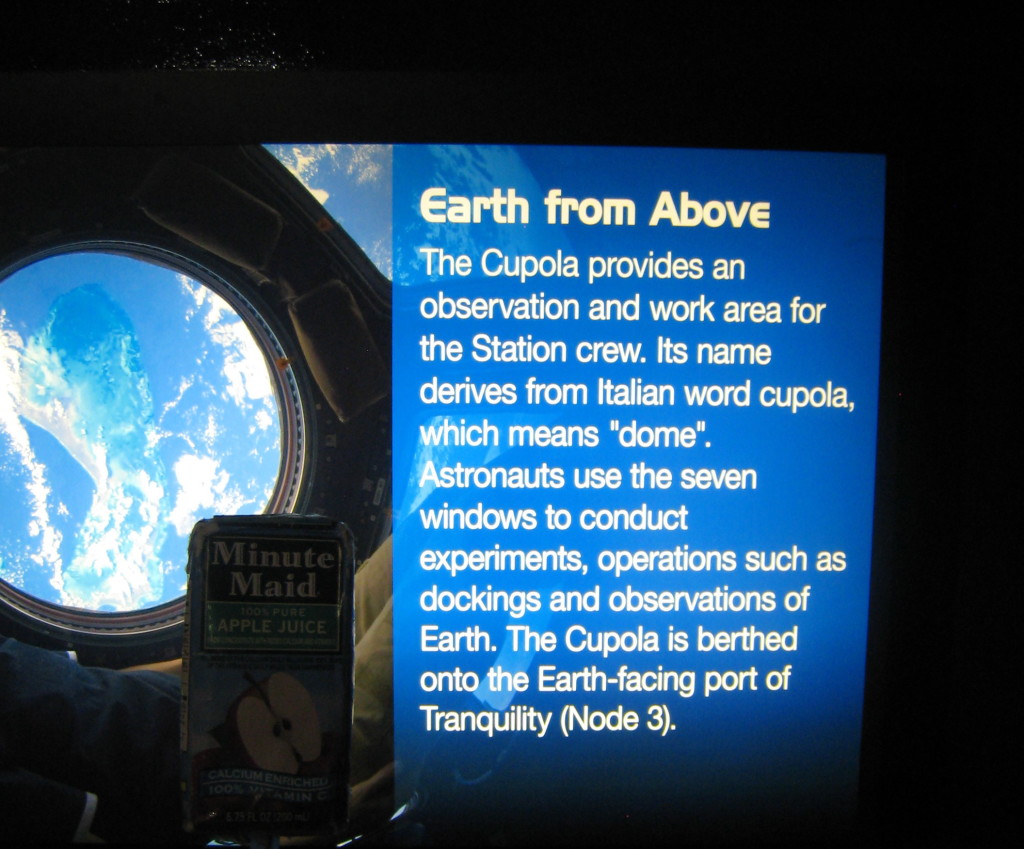
“Earth from Above ~ The Cupola provides an observation and work area for the Station crew. Its name derives from Italian word cupola, which means ‘dome’. Astronauts use the seven windows to conduct experiments, operations such as dockings and observations of Earth. The Cupola is berthed onto the Earth-facing port of Tranquility (Node 3).”

“Earth from Above ~ The Cupola not only provides spectacular views of Earth and celestial objects, but is also used to observe operations outside the station, such as robotic activities, approaching vehicles and spacewalks. It has six side windows and a top window, all of which are equipped with shutters to protect them from possible contamination, orbital debris and micrometeorites.” | Facts: – A European Space Agency (ESA) contribution – Name derives from Italian word cupola, which means ‘dome’ – Is attached to Earth-facing port of Tranquility (Node 3) – Has seven windows, six around the sides and one on top – Weights 4,136 lbs. (1,880 kg) – Houses computer workstations that control the station robotic arms – Two crew members can be in the cupola at a time – Pictures of the Venus transit across the sun and the Comet Lovejoy as it passed Earth have been taken from the Cupola.”
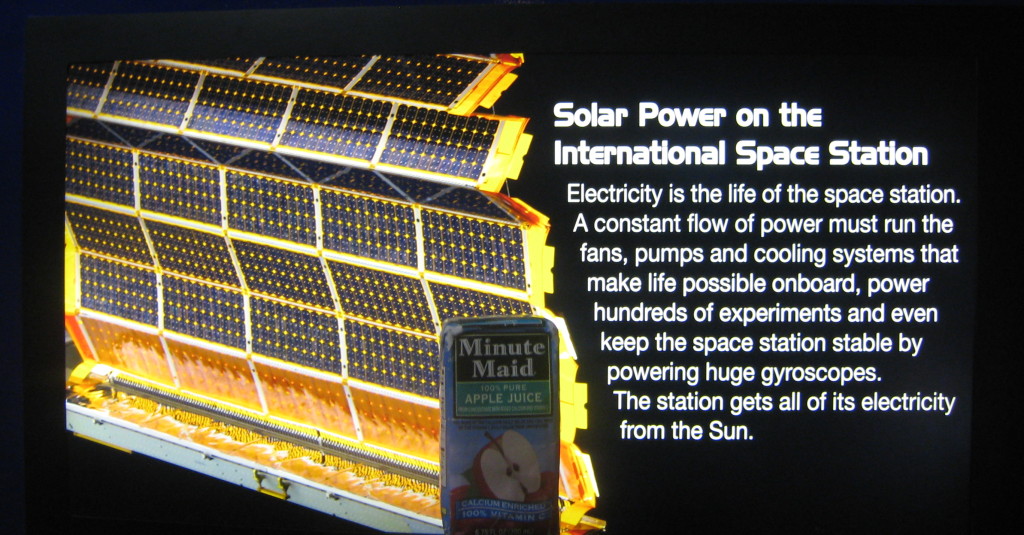
“Solar Power on the International Space Station ~ Electricity is the life of the space station. A constant flow of power must run the fans, pumps and cooling systems that make life possible onboard, power hundreds of experiments and even keep the space station stable by powering huge gyroscopes. The station gets all of its electricity from the Sun.”

“Solar Power ~ Solar power is the process of turning sunlight into electricity. The space station’s solar arrays contain more than a half-million individual photovoltaic cells made of purified silicon that convert light into electricity.”

“International Space Station Power Facts ~ | The eight solar array wings combined have almost an acre of surface area and over 512,000 individual solar cells | The photovoltaic cells, made of purified silicon, convert only light into power, not heat | The solar arrays can generate a total of 96 kilowatts of electricity | A huge swiveling joint allows the arrays to rotate as the space station flies so they always face the Sun | Eight miles of wire carry electricity to space station equipment | The wingspan of each of the four sets of solar array wings is 240 feet | Combined with additional solar arrays on Russian and other components of the station, the total power produced aboard the complex can be as much as 110 kilowatts, enough to power 55 average homes.”
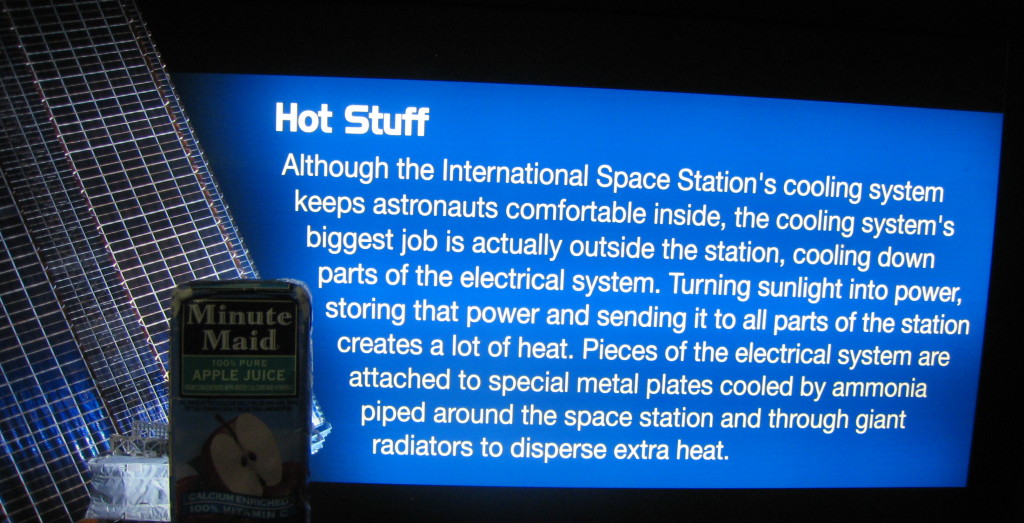
“Hot Stuff ~ Although the International Space Station’s cooling system keeps astronauts comfortable inside, the cooling system’s biggest job is actually outside the station, cooling down parts of the electrical system. Turning sunlight into power, storing that power and sending it to all parts of the station creates a lot of heat. Pieces of the electrical system are attached to special metal plates cooled by ammonia piped around the space station and through giant radiators to disperse extra heat.”

“Travel with the Sun ~ The spacecraft NASA is building to take people to places beyond Earth’s orbit will rely on solar power to generate electricity. Solar power will be a key element to provide the necessities of life for crews aboard distant spacecraft, or even on distant surfaces. Solar power already has been used to power robotic probes on Mars and other planets.”

“Batteries Included ~ The station needs constant power, but 16 times each day, the station is shaded from the Sun by the Earth during orbital night. Batteries provide power for the station during those nights. During daylight, the solar arrays generate the power to both run the space station and recharge the batteries.”

“Discovery ~ Space Shuttle Discovery first launched in 1986 and flew a total of 38 missions, travelling over 138 million miles and taking 252 crew members to space. Discovery flew to the International Space Station 13 times. Discovery’s deliveries to the station included three segments of the space station’s truss structure, the Harmony connecting module, the Japanese Kibo Laboratory and the permanent Leonardo module. Discovery is on public display at the Smithsonian Institution’s National Air and Space Museum Steven F. Udvar-Hazy Center in Virginia.”
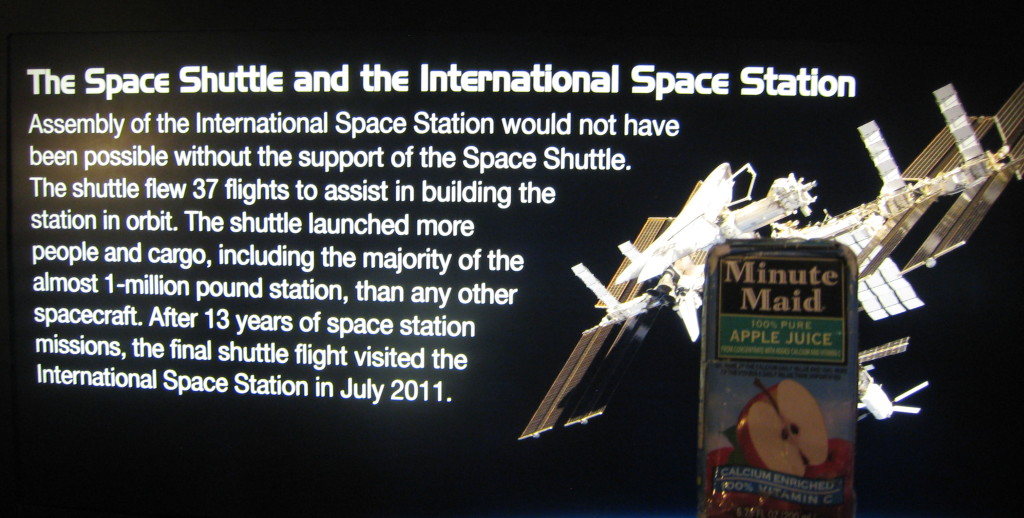
“The Space Shuttle and the International Space Station ~ Assembly of the International Space Station would not have been possible without the support of the Space Shuttle. The shuttle flew 37 flights to assist in building the station in orbit. The shuttle launched more people and cargo, including the majority of the almost 1-million pound station, than any other spacecraft. After 13 years of space station missions, the final shuttle flight visited the International Space Station in July 2011.”

“Endeavour ~ The Space Shuttle Endeavour first launched in 1992 and flew a total of 25 missions, travelling almost 123 million miles and taking 173 crew members to space. Endeavour flew to the International Space Station 12 times and began assembly of the International Space Station in orbit in 1998, attaching the U.S. Unity module to the Russian Zarya module. Endeavour’s later deliveries to the station included truss segments, the robotic Canadarm2, the Japanese Kibo lab’s logistics module and Exposed Facility, the Cupola and the Tranquility module. Endeavour is on public display at the California Science Center in Los Angeles, California.”

“Insulating Tile ~ This ceramic tile for the Orion spacecraft that NASA is building to take astronauts beyond Earth orbit was hit by a .12 inch (3.2 mm) aluminum pellet at 16,100 mph. Orion’s tiles are a tougher version of tiles used on the Space Shuttle. The same impact to a Space Shuttle tile would cause damage up to four times as severe.”
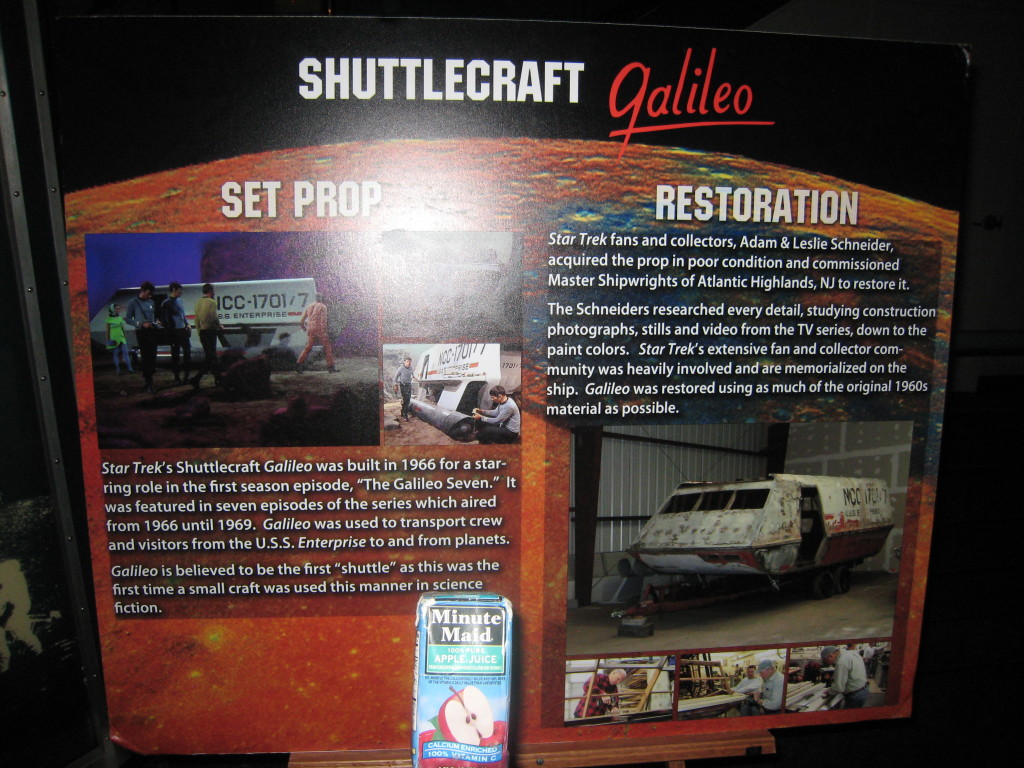
“Shuttlecraft Galileo ~ | Set Prop: Star Trek’s Shuttlecraft Galileo was built in 1966 for a starring role in the first season episode, ‘The Galileo Seven.’ It was featured in seven episodes of the series which aired from 1966 until 1969. Galileo was used to transport crew and visitors from the U.S.S. Enterprise to and from planets. Galileo is believed to be the first ‘shuttle’ as this was the first time a small craft was used this manner in science fiction | Restoration: StarTrek fans and collectors, Adam & Leslie Schneider, acquired the prop in poor condition and commissioned Master Shipwrights of Atlantic Highlands, NJ to restore it. The Schneiders researched every detail, studying construction photographs, stills and video from the TV series, down to the paint colors. StarTrek’s extensive fan and collector community was heavily involved and are memorialized on the ship. Galileo was restored using as much of the original 1960s material as possible.”
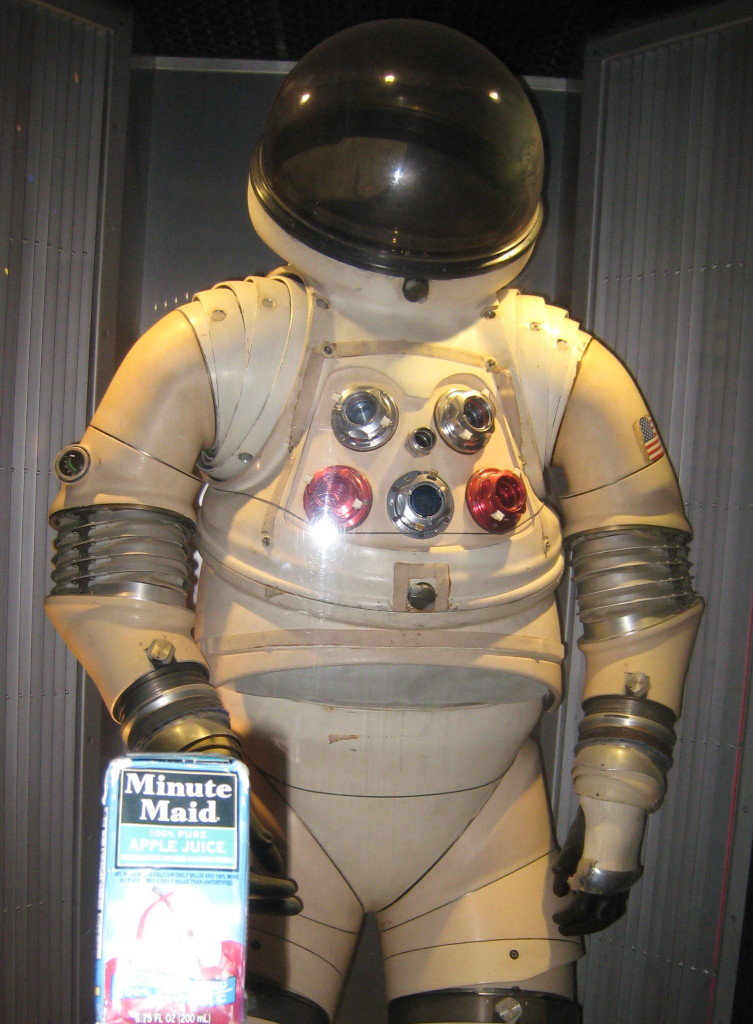
“RX-5 ~ Looking at the RX-5 Hard Suit, you might be reminded of a knight’s protective armor. Similarly, spacesuits are designed to protect astronauts when they are confronted with the potentially lethal environment of space. Because there is no atmospheric pressure and no oxygen in space, and because extreme temperatures and the potential of being hit by orbital debris are ever-constant threats – hard suits, such as the prototype RX-5, have been designed for extended Moon exploration and extended spacewalks. | Although the RX-5 was determined to be too heavy, too bulky and too difficult to store on the Apollo spacecraft and therefore was never used on the Moon — it represents an important beginning for the design of future hard suits that will be necessary if humans are to continue to explore space for longer periods of time. The RX-5 hard suit was one of seven RX (Rigid Experimental) suits developed between 1962 and 1968 under NASA sponsorship.”

“Plastic Debris ~ This 4-inch thick aluminum block was hit by a 1-inch, half-ounce plastic cylinder at 15,200 mph. The plastic went almost all the way through the block, showing even plastic can be damaging at orbital speeds. Most debris is metal, but some is plastic. | Aluminum Plate ~ This 1.5-inch thick aluminum plate was hit by a quarter-inch (6 mm) diameter by half-inch (12 mm) long aluminum cylinder at a speed of 14,300 mph (6.4 km/s).”

“Mercury 3 – Freedom 7 – Shepard” | “Mercury 3 (May 5, 1961) ~ Alan Shepard – | The first American in space, Alan B. Shepard, launches in a Redstone rocket. His capsule, the ‘Freedom 7,’ makes a 15 minute sub-orbital flight, reaching an altitude of 116.5 miles from Cape Canaveral (later named Kennedy Space Center). Less than a month earlier, Yuri Gagarin becomes the first human in space. Shepard may have flown into space as early as March 1961 and beaten Gagarin into space, but a faulty switch causes an overshoot of the landing target area during one of Mercury’s chimpanzee test flights. NASA thus elects to fly a second test flight before committing to human missions.”

“Mercury 4 – Liberty Bell 7 – Grissom” | “Mercury 4 (July 21, 1961) ~ Gus Grissom ~ | Virgil I. ‘Gus’ Grissom rides into space in the ‘Liberty Bell 7’. His flight is successful and almost identical in duration and objective to NASAs first human spaceflight, but after splashdown, the capsule hatch blows open unexpectedly, and water starts pouring inside. Grissom is rescued by a helicopter just moments before the capsule sinks nearly three miles to the bottom of the ocean. The ‘Liberty Bell’ is seemingly lost about 300 miles off the coast of Florida until it is finally recovered and returned to land July 21, 1999, exactly 38 years after its flight into space.”

“Mercury 6 – Friendship 7 – Glenn” | “Mercury 6 (February 20, 1962) ~ John Glenn – | John H. Glenn is the first American to orbit the Earth. Propelled by the more powerful Atlas rocket, Glenn orbits the Earth three times in the ‘Friendship 7’ capsule. Though a faulty heat shield signal causes concerns, Glenn lands safely in the Atlantic Ocean after almost five hours or space-flight. Glenn performs a number of tests in micro-gravity and doesn’t suffer from the same space sickness which Russian Cosmonaut Gherman Titov experiences during his 17 orbit flight six months earlier.”

“Mercury 7 – Aurora 7 – Carpenter” | “Mercury 7 (May 24, 1962) ~ Scott Carpenter – | M. Scott Carpenter orbits the Earth three times in his capsule, ‘Aurora 7,’ and is the first astronaut to eat in space and see a sunset in space. After a successful flight that includes aerodynamic testing, he spends three hours in his raft in the Caribbean waiting to be picked up by helicopters. Various factors contribute to a 250-mile overshot of his splashdown target area, delaying the recovery efforts.”
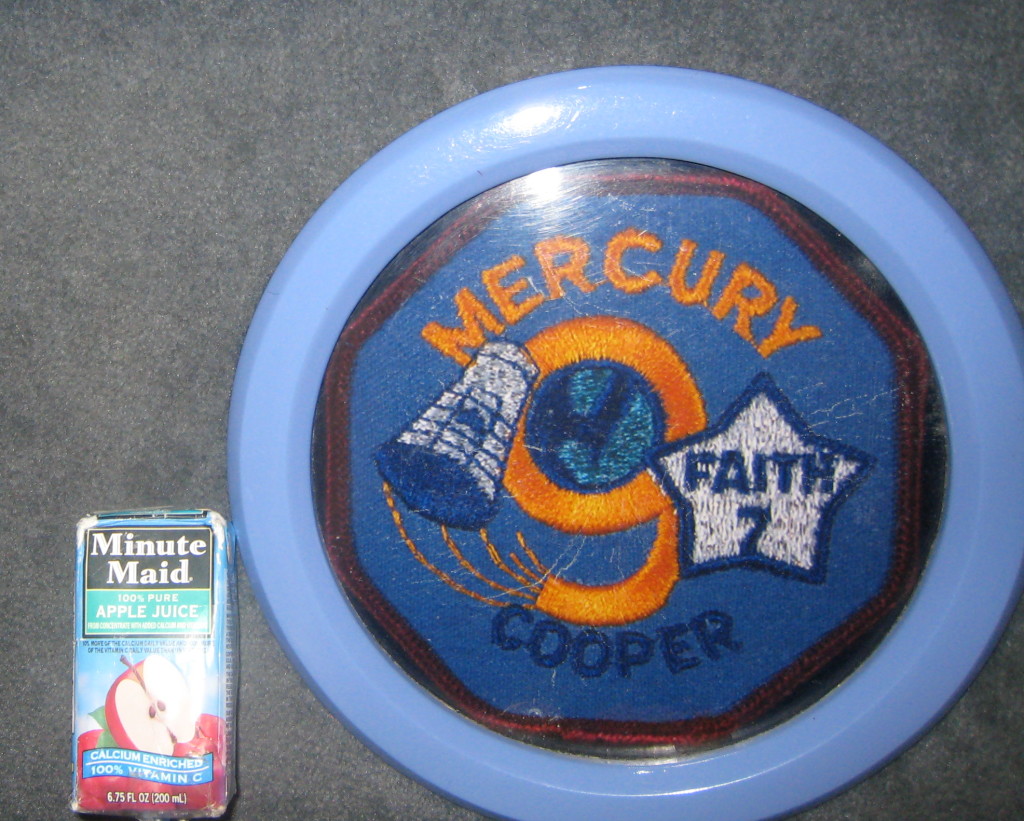
“Mercury 9 – Faith 7 – Cooper” “Mercury 9 (May 15, 1963) ~ Gordo Cooper – L. Gordon ‘Gordo’ Cooper flies the last flight of the Mercury series. The ‘Faith 7’ orbits the Earth 22 times in 34 hours, during which Cooper collects data to determine the effects of extended spaceflight on humans. He deploys a small satellite with xenon strobe lights to test his ability to see a light of known intensity in space — which will be important in rendezvous missions of the Gemini Program. Cooper takes color photographs and movies of Earth and sends the first TV pictures from an American spacecraft. After a textbook flight, Cooper pilots the capsule back to Earth when automatic reentry devices fail.”
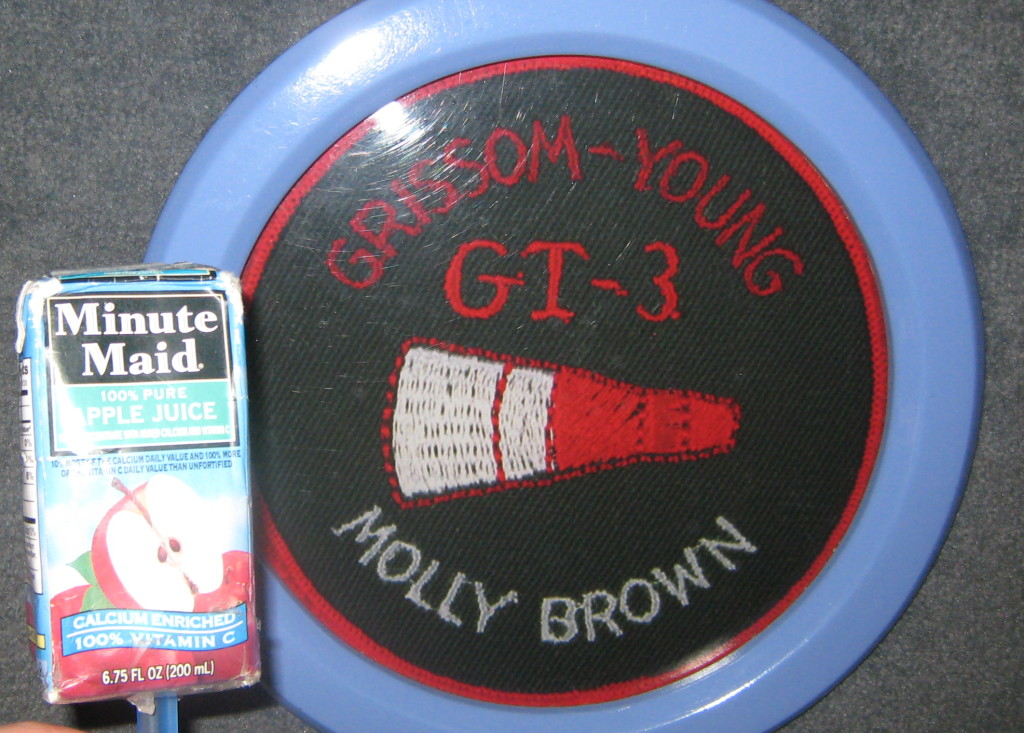
“GT-3 – Molly Brown ~ Grissom-Young” “Gemini III (March 23, 1965) ~ Gus Grissom – John Young ~ | Virgil I. ‘Gus’ Grissom becomes the first human to travel in space twice when he and John W. Young orbit the Earth three times in their capsule, the ‘Molly Brown.’ Three times during the five-hour flight Grissom changes the capsule’s orbit — the first occasion an American piloted spacecraft alters course. After this mission, Gemini modules are no longer given names, and the flights are designated by roman numerals.”

“Gemini 4 – First Spacewalk ~ McDivitt – White” “Gemini IV (June 3-7, 1965) ~ Jim McDivitt – Ed White ~ | Astronaut Edward H. White performs the first American ‘walk’ in space. His space walk takes him over the United States, from the coast of California to south of Florida. White floats in space for 20 minutes at an altitude of 100 miles and a speed of 17,500 mph. Connected to the spacecraft by a 25-foot tether that supplies oxygen and communications, he moves around the outside of the capsule using a small jet for propulsion. ‘It’s the saddest moment of my life,’ White admits when told to get back inside his spacecraft. Soviet Cosmonauts had performed a space walk three months earlier.”

“Gemini 5 – 8 Days or Bust ~ Cooper – Conrad” | “Gemini V (August 21-29, 1965) ~ Gordo Cooper – Pete Conrad ~ | L. Gordon ‘Gordo’ Cooper and Charles ‘Pete’ Conrad break the Soviet record for longest spaceflight and for total hours in space to date. The Soviet Union would not catch America in total hours in space for 13 years. Gemini V stays in orbit eight days — long enough to fly to the Moon, explore its surface and return — completing 120 orbits around the Earth. Both astronauts lose weight in space — an average of a pound a day and grow heavy beards.”

“GTA-6 ~ Schirra – Stafford” | “Gemini VI (December 15-16, 1965) ~ Wally Schirra – Tom Stafford – | Originally Walter M. Schirra and Thomas P. Stafford are to perform a rendezvous with an Agena spacecraft, an 11-foot unoccupied target vehicle, but after the Agena fails to go into orbit, NASA approves a rendezvous attempt with Gemini VII. The 185-mile-high encounter takes place December 15, 1965. Gemini VI is launched after Gemini VII because it has the radar required for the maneuver. Gemini VI astronauts navigate through four orbits to catch Gemini VII and fly in tight formation for five orbits, completing a successful rendezvous.”
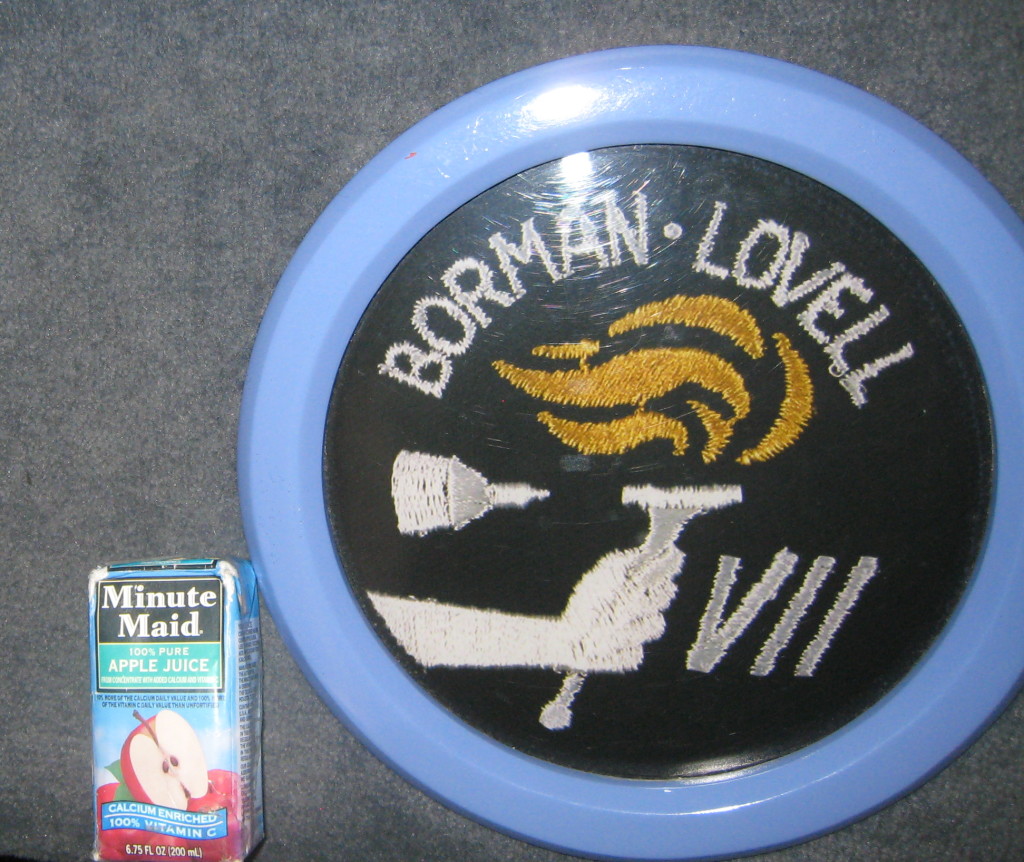
“Gemini VII ~ Borman – Lovell” | “Gemini VII (December 4-18, 1965) ~ Jim Lovell – Frank Borman ~ | James A. Lovell and Frank Borman spend two weeks in Earth orbit. Their mission includes mostly medical experiments regarding human endurance in space. Halfway through their mission, Gemini VII serves as a target for the first American rendezvous in space. Gemini VI comes to within six feet of Gemini VII, and the two spacecraft orbit the Earth flying in tight formation for six hours.”
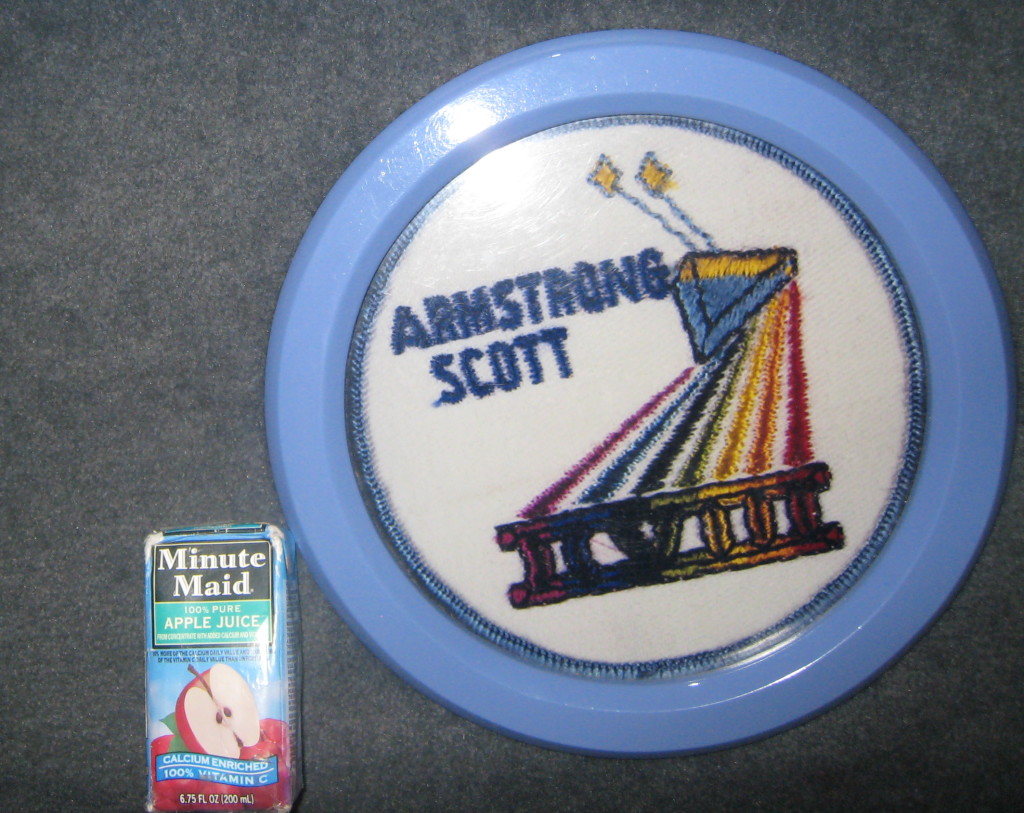
“Gemini VIII ~ Armstrong – Scott” | “Gemini VIII (March 16-17, 1966) ~ Neil Armstrong – Dave Scott ~ | Neil A. Armstrong and David R. Scott successfully rendezvous and dock with Agena, an 11-foot unoccupied target vehicle. After docking, the two docked vehicles suddenly begin rolling out of control, due to an electrical short circuit. Armstrong undocks, but the Gemini capsule begins to tumble at a dizzying rate of one revolution per second. The crew is forced to abort the mission by switching to back-up thrusters usually reserved only for reentry. The spacecraft makes an emergency, but safe, landing in the Pacific Ocean.”
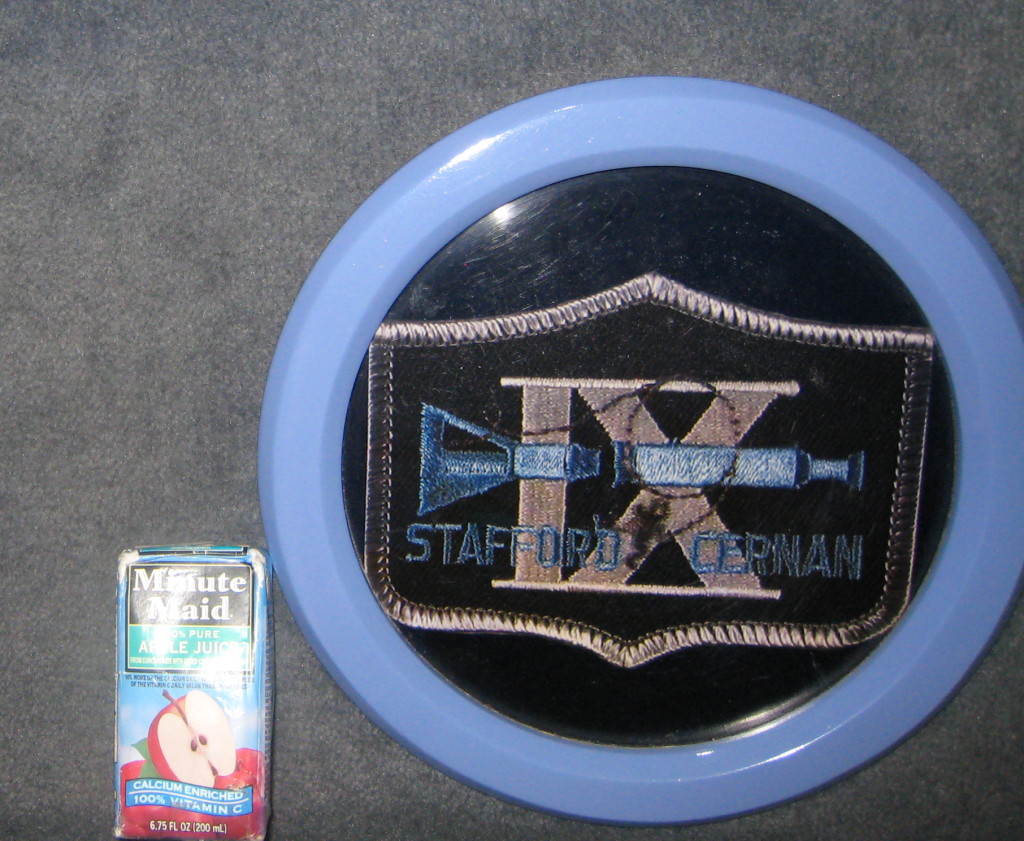
“Gemini IX ~ Stafford – Cernan” | “Gemini IXA (June 3-6, 1966) ~ Tom Stafford – Gene Cernan – | Thomas P. Stafford and Eugene A. Cernan attempt another docking with the Agena spacecraft, an 11-foot unoccupied target vehicle. The Agena, or ‘angry alligator,’ as it becomes known, opens only partially and the docking has to be aborted. Later in the three-day mission, Cernan exits the spacecraft for a record two-hour space walk. The Gemini capsule splashes down only 769 yards from their recover Navy ship — the most accurate landing to date. The mission is designated by a suffix ‘A’ because a back-up crew flies instead of the original crew, Elliot See and Charles Bassett, who are killed in a jet flying accident a few months earlier.”
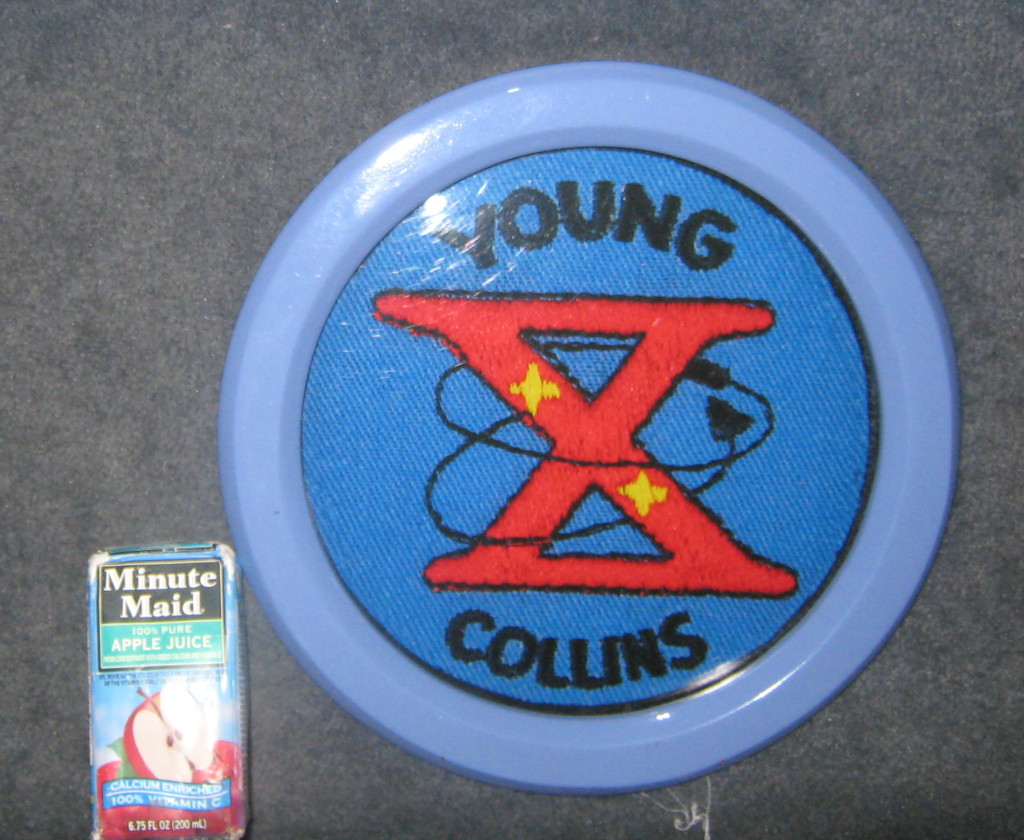
“Gemini X ~ Young – Collins” | “Gemini X (July 18-21, 1966) ~ John Young – Mike Collins ~ | John W. Young and Michael Collins successfully dock with their Agena target. Using Agena’s engines, the Gemini X capsule climbs to a record orbit, 475 miles at its peak. Later during the mission, Gemini X docks with the Gemini VIII Agena, which is still in orbit, and Collins performs space walking exercises that include retrieving an experiment package.”

“Gemini XI ~ Conrad – Gordon” | “Gemini XI (September 12-15, 1966) ~ Pete Conrad – Dick Gordon ~ | After docking with the Agena target during their first obrit, Charles ‘Pete’ Conrad and Richard F. Gordon create temporary artificial gravity in space by attaching a 100-foot tether between their capsule and Agena. ‘Ride’em cowboy!’ Gordon exclaims as he sits astride the spacecraft nose while he attaches the tether during a space walk. When the two spacecraft undock, the tether becomes taut, and the spacecraft begin orbiting around each other, like the ends of a baton. Gemini XI sets a new high altitude record of 850 miles above the Earth.”
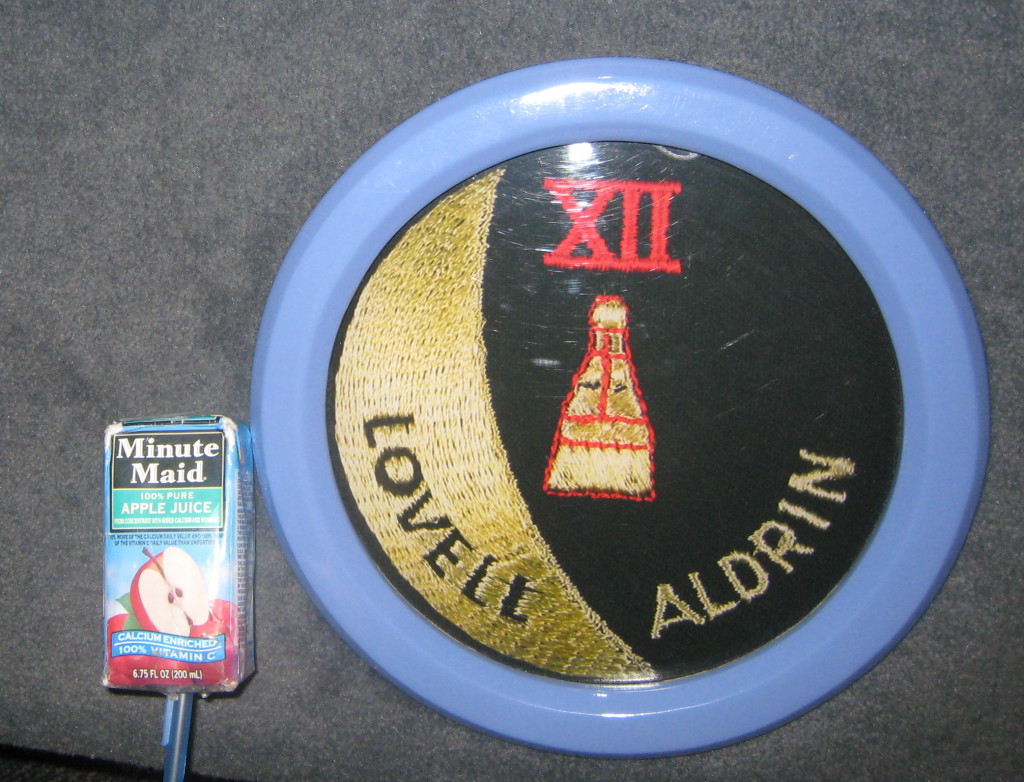
“Gemini XII ~ Lovell – Aldrin” | “Gemini XII (November 11-15, 1966) ~ Jim Lovell – Buzz Aldrin ~ | James A. Lovell and Buzz Aldrin accomplish docking with the Agena target and perform open-door exercises during the last flight in the Gemini series. Aldrin rests regularly during the two-hour space walk — the longest to date — and is able to overcome the space walking fatigue that others have experienced.”
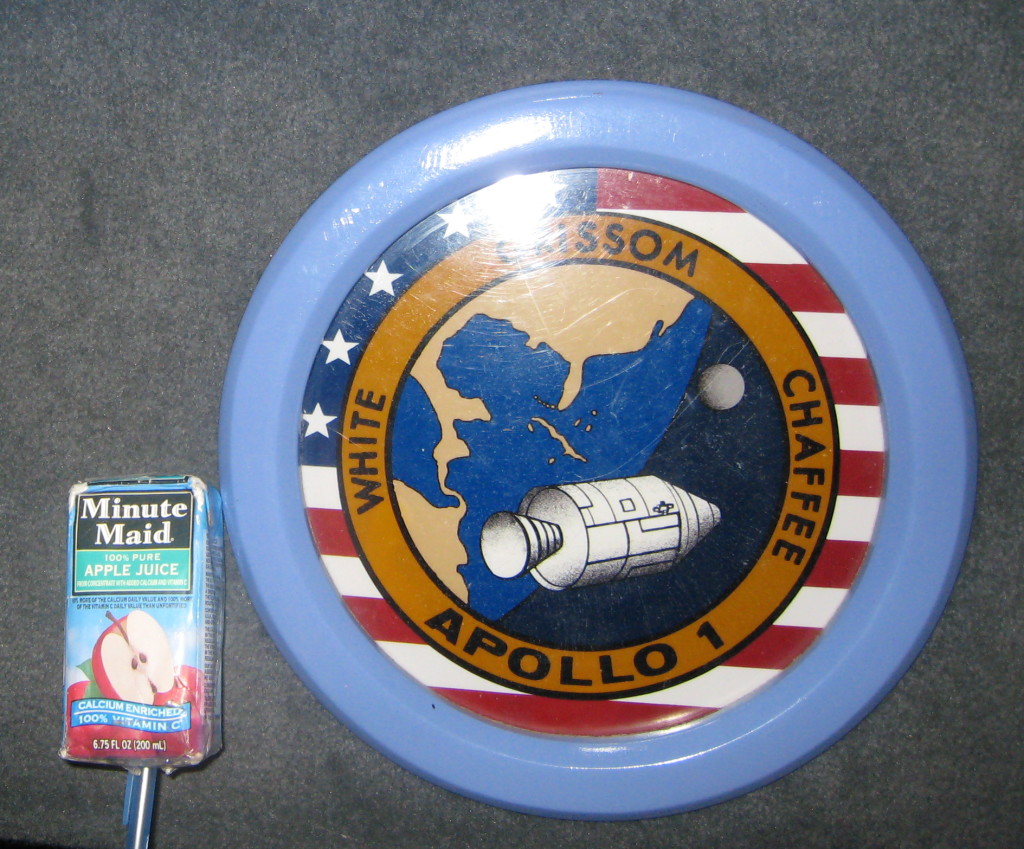
“Apollo 1 ~ White – Grissom – Chaffee” | “Apollo 1 (January 27, 1967) ~ Gus Grissom – Ed White – Roger Chaffee ~ | America’s space program receives a major setback when astronauts Virgil I. ‘Gus’ Grissom, Edward H. White, and Roger B. Chaffee are killed in a fire during a routine ground test at Kennedy Space Center. Three weeks before the scheduled launch of the first three-person Apollo spacecraft, an electrical fire starts in the sealed capsule environment of pure oxygen while the crew conducts a pre-flight test. The tragedy forces substantial redesign of the Apollo spacecraft and a thorough restudy of procedures.”
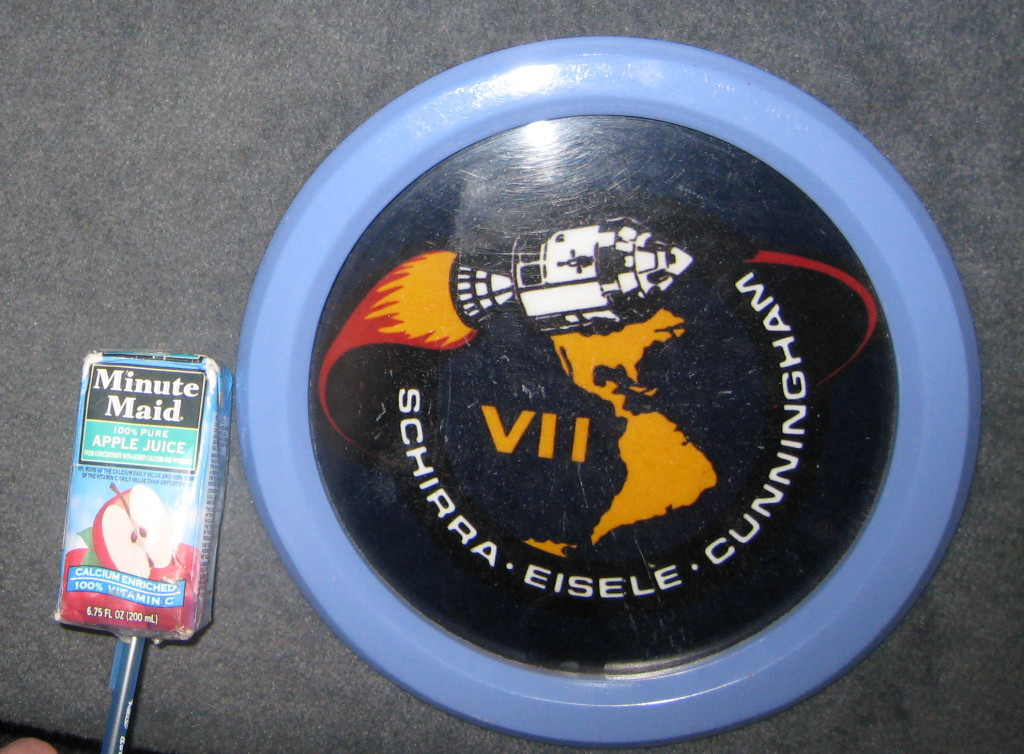
“Apollo VII ~ Schirra – Eisele – Cunningham” | “Apollo 7 (October 11-22, 1968) ~ Wally Schirra – Donn Eisele – Walt Cunningham ~ | Walter M. Schirra, Donn F. Eisele, and Walter Cunningham fly the first human mission after the Apollo 1 fire (Apollo 2 through Apollo 6 are unpiloted test flights). They orbit the Earth 163 times inside a completely redesigned space capsule that is launched atop a Saturn IB rocket. The crew tests the many engineering systems and conducts several complicated rendezvous maneuvers in preparation for the upcoming first flight to the Moon during Apollo 8. The world sees the first live images of a spaceflight during TV broadcasts from the Apollo 7 capsule.”
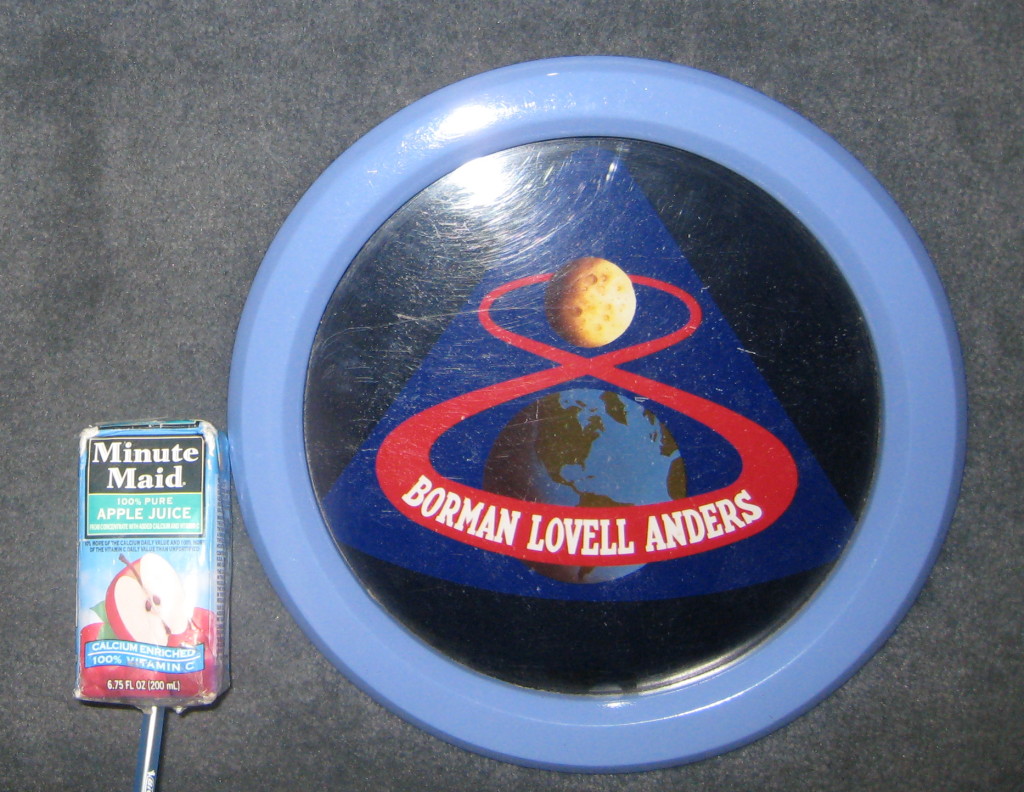
“Apollo 8 ~ Borman – Lovell – Anders” | “Apollo 8 (December 21-27, 1968) ~ Frank Borman – Jim Lovell – Bill Anders ~ | The bold flight is the first piloted test of the gigantic Saturn V rocket, including its 7.5 million pounds of lift-off thrust. The spacecraft and the crew, Commander Frank Borman, Command Module Pilot James A. Lovell, and Lunar Module Pilot William A. Anders, reach the Moon three days after lift-off and complete 10 orbits around it. While in orbit around the Moon, the crew looks for landing sites and broadcasts views from their capsule, including a Christmas Eve reading of Genesis.”

“Apollo IX ~ McDivitt – Scott – Schweickart” | “Apollo 9 (March 3-13, 1969) ~ Jim McDivitt – Dave Scott – Rusty Schweickart ~ | The first space space test and rendezvous maneuvers of the lunar module (LM) are conducted by astronauts James A. McDivitt, David R. Scott and Russell L. Schweickart in Earth orbit. In many ways harder than the orbit mission around the Moon, the testing mission for the LM is highly successful. The LM pulls free of the command module and flies on its own for six-and-a-half hours. After the tests on the LM are completed, it is jettisoned because it is not designed to survive the intense heat of reentry.”

“Apollo X ~ Stafford – Young – Cernan” | “Apollo 10 (May 18-26, 1969) ~ Tom Stafford – John Young – Gene Cernan ~ | The most experienced team to date completes the final dress rehearsal for a human Moon landing. The 44-ton Apollo assembly flies 240,000 thousand miles in three days to a lunar orbit. While Command Module Pilot John Young watches from the command module, ‘Charlie Brown,’ Commander Thomas P. Stafford and Lunar Module Pilot Eugene A. Cernan unhook the lunar module ‘Snoopy’ and make two low-level passes at the Moon’s surface and return to the ‘Charlie Brown’. The crew also broadcasts color TV transmissions, and become the first men to shave in space.”

“Apollo 11” | “Apollo 11 (July 16-24, 1969) ~ Neil Armstrong – Mike Collins – Buzz Aldrin ~ | Men walk on the Moon for the first time. While Command Module Pilot Michael Collins tracks the mission’s progress and relates it back to Houston from the command module ‘Columbia,’ Commander Neil A. Armstrong and Lunar Module Pilot Buzz Aldrin undock and land the lunar module “Eagle’ on the Moon. After completing the first moonwalk, they use ‘Eagle’ to return to ‘Columbia’. Being too heavy to take back to Earth, the ‘Eagle’ eventually crashes back onto the lunar surface as planned. Safely back on Earth, the Apollo 11 crew spends two weeks in quarantine as a precaution against any lunar bacteria they may have contacted.”

“Apollo XII ~ Conrad – Gordon – Bean” | “Apollo 12 (November 14-24, 1969) ~ Pete Conrad – Dick Gordon – Al Bean ~ | Although lightning strikes their Saturn V rocket during launch, it does not negatively affect the second mission to land astronauts on the Moon. While Commander Charles ‘Pete’ Conrad and Lunar Module Pilot Alan L. Bean accomplish a pinpoint landing in the ‘Intrepid’ — only 535 feet from the Surveyor 3 unpiloted spacecraft already on the Moon’s surface — Command Pilot Richard F. Gordon pilots the ‘Yankee Clipper’ command module around the Moon.”

“Apollo XIII ~ Luna, Scientia” | “Apollo 13 (April 11-17, 1970) ~ Jim Lovell – Jack Swigert – Fred Haise ~ | James A. Lovell, John L. ‘Jack’ Swigert, and Fred W. Haise are lucky to return safely to Earth after the only deep space abort in 22 U.S. piloted flights. An oxygen tank explodes in the service module, causing a string of system failures. Because the command module, ‘Odyssey,’ is left almost completely out of power, the crew uses the two-person lunar module, ‘Aquarius,’ as a lifeboat during a crowded and tense four-day journey back to Earth. Their success proves the Apollo program’s ability to weather a major crisis and bring the crew back home safely.”

“Apollo 14 ~ Shepard – Roosa – Mitchell” | “Apollo 14 (January 31 – February 9, 1971) ~ Alan Shepard – Stuart Roosa – Ed Mitchell – | Commander Alan B. Shepard, America’s first astronaut in space, and Lunar Module Pilot Edgar D. Mitchell land the lunar module, ‘Antares,’ within 130 feet of its target on the lunar surface. They collect 95 pounds of Moon rocks as geologic samples, and still have time to hit a couple of golf balls with a club they fashion out of a piece of lunar equipment. The third crew member, Command Module Pilot Stuart A. Roosa, remains in the command module, ‘Kitty Hawk’, taking pictures, tracking landmarks on the Moon, and maintaining the spacecraft’s systems.”

“Apollo 15 ~ Scott – Worden – Irwin” | “Apollo 15 (July 26 – August 7, 1971) ~ Dave Scott – Al Worden – Jim Irwin ~ | Commander Dave Scott and Lunar Module Pilot James B. Irwin land in the lunar mountains aboard the ‘Falcon.’ They explore the surface of the Moon in the first lunar rover. Trained as lunar field geologists, they spend more than 66 hours collecting geological samples. They find the ‘Genesis Rock,’ a 4.1 billion-year old rock that helps scientists learn more about the Moon and its volcanic history. Command Module Pilot Alfred M. Worden conducts scientific analyses through sensing apparatus aboard the command module, ‘Endeavor.’ Apollo 15 is the first crew not to have to endure quarantine — it has become clear that this precaution is not necessary.”

“Apollo 16 ~ Young – Mattingly – Duke” | “Apollo 16 (April 16-27, 1972) ~ John Young – Ken Mattingly – Charlie Duke ~ | Making one of the greatest leaps in the understanding of the Moon since the first lunar landing, Apollo 16 advances our understanding of the Moon’s history as a progression of violent cosmic bombardment. Commander John W. Young and Lunar Module Pilot Charles M. Duke land the ‘Orion’ at the highest lunar landing — at an elevation of almost 25,700 feet — in the Descartes Highlands. Command Module Pilot Thomas K. Mattingly’s photographs, observations, and data from ‘Casper,’ the command module, help scientists extend their geological findings.”

“Apollo XVII ~ Cernan – Evans – Schmitt” | “Apollo 17 (December 7-19, 1972) ~ Gene Cernan – Ron Evans – Jack Schmitt ~ | During a nighttime launch, command module ‘America,’ and lunar module ‘Challenger’ travel to the Moon for the last Apollo mission. Commander Eugene A. Cernan and Lunar Module Pilot Harrison ‘Jack’ Schmitt spend 75 hours on the Moon, gathering geological information that leads scientists to improve models for lunar evolution. Schmitt is the only astronaut trained as a scientist to walk on the Moon. On their way back to Earth, Command Pilot Ronald E. Evans performs a space walk to retrieve film canisters from the service module. Cernan, the last astronaut to walk on the Moon, states, ‘It has been a beginning. I don’t think there will ever be an end, not as long as man is alive and willing.”

“Gemini 5 Spacecraft (Artifact on loan from the National Air and Space Museum, Smithsonian Institution)~ | This is the actual Gemini spacecraft in which astronauts Gordon Cooper and Charles ‘Pete’ Conrad flew for the Gemini 5 mission, August 21-29, 1965. It was the third manned flight of the Gemini Program. | Designed to take two astronauts at a time, the Gemini Program was aptly named after the constellation named the ‘Twins’. Gemini capsules look like enlarged versions of the Mercury capsule, it only offered astronauts a little more cabin space. John Young, who flew in the first Gemini mission, described sitting in the Gemini capsule as ‘sitting in a phone booth that was lying on its side.'”
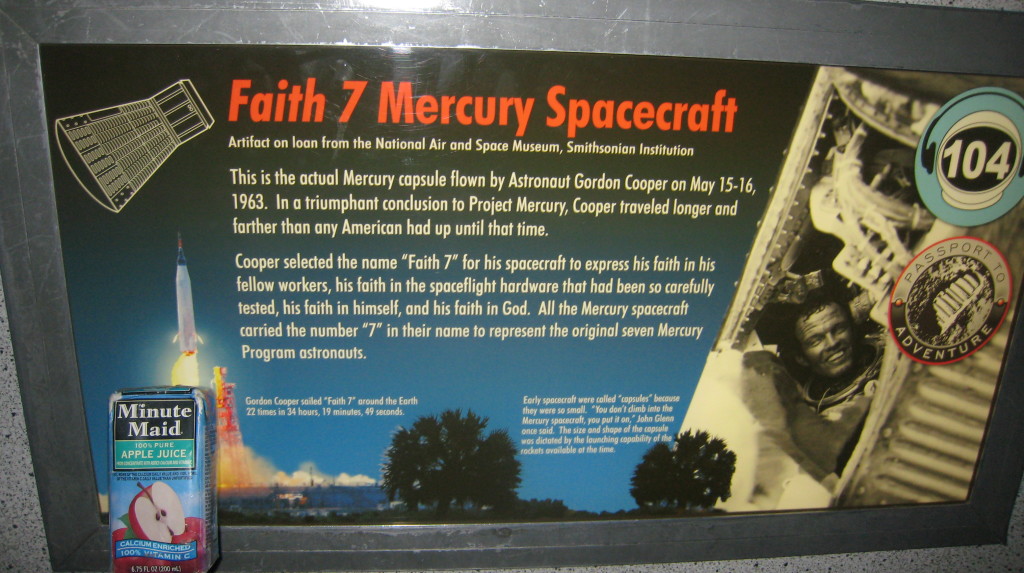
“Faith 7 Mercury Spacecraft (artifact on loan from the National Air and Space Museum, Smithsonian Institution) ~ This is the actual Mercury capsule flown by Astronaut Gordon Cooper on May 15-16, 1963. In a triumphant conclusion to Project Mercury, Cooper traveled longer and farther than any American had up until that time. Cooper selected the name ‘Faith 7’ for his spacecraft to express his faith in his fellow workers, his faith in the spaceflight hardware that had been so carefully tested, his faith in himself, and his faith in God. All the Mercury spacecraft carried the number ‘7’ in their name to represent the original seven Mercury Program astronauts.”

“Explorer 1 (Artifact on loan from NASA-JSC) ~ | This is a full-scale replica of Explorer 1, the first American satellite sent into orbit. Its launch on January 31, 1958, just months after the sensational flights of the Soviet Union’s Sputnik 1 and 2, marked the official beginning of the space age for the United States and was a definite boost for America as the superpowers struggled over the conquest of space. Explorer 1 was launched from Cape Canaveral (now Kennedy Space Center) by a rocket which was designed by German-born rocket scientist Wernher von Braun. Von Braun’s rocket design and development in the United States culminated with the Saturn rockets that launched the Apollo missions to the Moon. Explorer 1 made the first scientific discovery from space. Designed to study cosmic rays, it detected areas of intense radiation around the Earth using a device created by scientist James Van Allen. These radioactive areas trapped by the Earth’s magnetic field, became known as the Van Allen belts.”
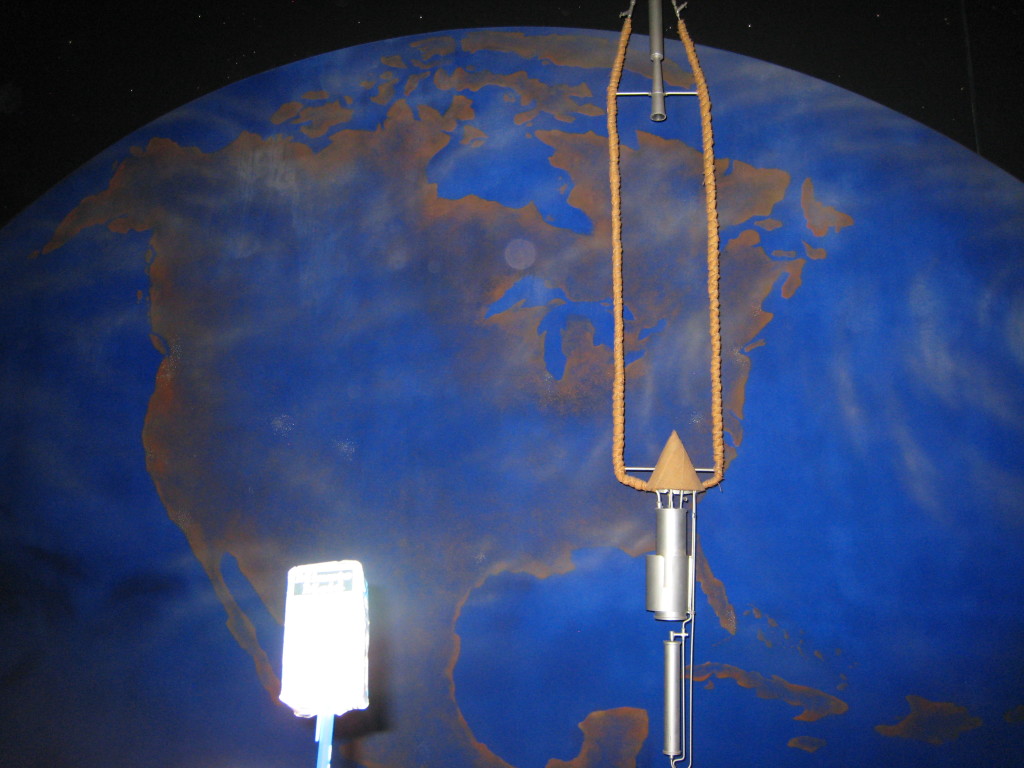
“Goddard’s Liquid Fueled Rocket (artifact on loan from NASA-JSC) ~ | Rocket pioneer Dr. Robert H. Goddard launched the first liquid-fueled rocket on March 16, 1926. This is an identical replica of the original rocket, which burned liquid oxygen and gasoline and rose 41 feet and traveled 184 feet at an average of 60 mph. | Before Goddard’s liquid-fueled rocket, rockets used gunpowder and other forms of solid rocket propellant. Goddard unofficially inaugurated the space age and changed the future of rocketry when he began using liquid fuels, which produce more acceleration. For the first time, space flight became a real possibility. | Goddard’s early rocket had an unfamiliar design: it had the combustion chamber and nozzle of the top of a frame made up of two vertical tubes, which carried the liquid fuel from the tanks at the bottom.”

“America Apollo 17 Command Module (artifact on loan from the National Air and Space Museum, Smithsonian Institution) ~ Flown: December 7-19, 1972 ~ Crew: Eugene Cernan, Ronald Evans, Harrison Schmitt ~ Apollo 17 was the last mission of Project Apollo. The Apollo 17 spacecraft is the last manned spacecraft to have traveled to the Moon. The Apollo 17 crew returned safely to Earth in this capsule, named America, ending an era in history. This actual, flown Command Module orbited the Moon and housed astronaut Ron Evans while astronauts Gene Cernan and Harrison Schmitt headed to the surface aboard the Lunar Module. The extreme heat produced during re-entry into Earth’s atmosphere charred America’s under-side. Commander Eugene Cernan, the last man to walk on the Moon, said in farewell, ‘…we leave as we came, and God willing, as we shall return: with peace and hope for all mankind.”

“Lunar Rover Trainer (artifact on loan from the National Air and Space Museum, Smithsonian Institute) ~ Rovers were taken to the Moon’s surface – and left there each time – on the last three Apollo missions. Astronauts Dave Scott and Jim Irwin (Apollo 15), John Young and Charlie Duke (Apollo 16), and Gene Cernan and Jack Schmitt (Apollo 17), practied in this Lunar Rover Trainer here in Houston in preparation for their Apollo missions. | Since it was not needed on the Moon’s airless surface, the rover had no steering wheel or brakes. It was started, steered, and stopped by a single control located between the two seats. The electric-powered rover could travel at almost 10 mph and had a range of about 55 miles. It was equipped with a TV camera, which recorded the astronauts’ exploration of the Moon and liftoff of the top half of the Lunar Module when the astronauts left the Moon.”
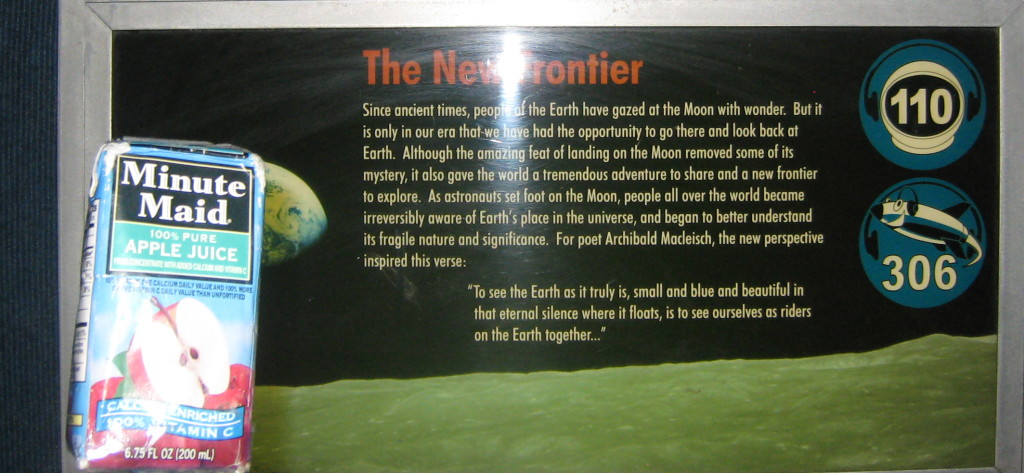
“The New Frontier ~ Since ancient times, people of the Earth have gazed at the Moon with wonder. But it is only in our era that we have had the opportunity to go there and look back at Earth. Although the amazing feat of landing on the Moon removed some of its mystery, it also gave the world a tremendous adventure to share and a new frontier to explore. As astronauts set foot on the Moon, people all over the world became irreversibly aware of Earth’s place in the universe, and began to better understand its fragile nature and significance. For poet Archibald Macleisch, the new perspective inspired this verse: ‘To see the Earth as it truly is, small and blue and beautiful in that eternal silence where it floats is to see ourselves as riders on the Earth together…'”
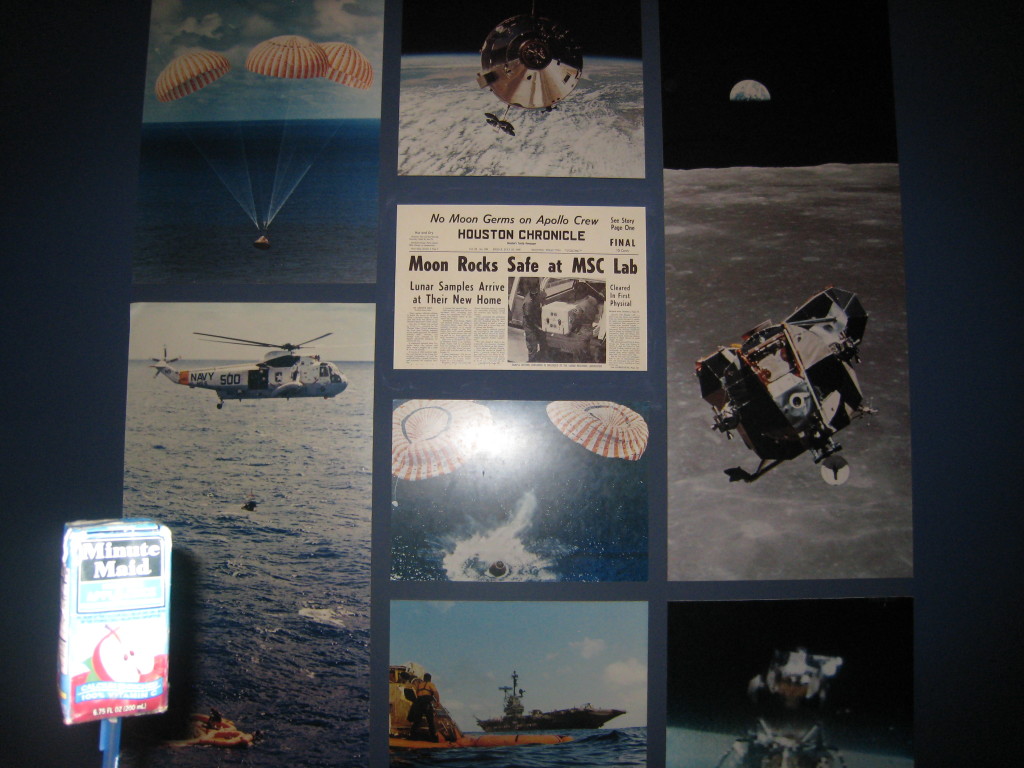
“Houston Chronicle – No Moon Germs on Apollo Crew | Moon Rocks Safe at MSC Lab | Lunar Samples Arrive at their New Home”

(1ST PANEL)…….”The Lunar Laboratory ~ Between 1968 and 1972, America sent nine expeditions to the Moon, and a total of 12 astronauts collected samples and returned them to Earth for study. Back on our planet, the astronauts’ priceless collection went to the Lunar Receiving Laboratory here at the Johnson Space Center. In total, some 2,000 lunar samples were collected and had a combined weight of approximately 843 pounds. This collection is now kept in the vaults of the Lunar Curatorial Facility, where the samples are preserved and protected in an atmosphere of pure nitrogen, and remains a continuing source of knowledge as scientists learn about the nature and origin of the Moon. The oldest sample is nearly 4.6 billion years old. This laboratory is designed to show you how the scientists have studied the Moon rocks over the years and the techniques they use to process this unique collection.”……….(2ND PANEL) “Lunar Core Samples ~ In addition to bringing various Moon rocks back to Earth, the Apollo astronauts dug deep into the lunar surface to collect ‘core samples.’ They did this by drilling hollow core tubes approximately 10 feet into the soil of the Moon. The fine-grained lunar soil, which has slowly built up layer by layer over millions of years, is the product of countless meteorite impacts — some small, and others large and incredibly violent. These meteorite impacts gradually broke surface rocks down to particles. Each new layer was exposed to the Sun before it was buried. As scientists test the core samples, important evidence about the Sun is revealed. The oldest layers, at the bottom of some of the cores, were deposited about 500 million years ago and tell us about the Sun long ago. Younger layers give information about the Sun at various times up to the present. Because there is such a wealth of information found in these cores, great care is taken to open and remove the samples for analysis. As you can see, the scientists working on these core samples uses a special glove box containing pure nitrogen so the specimens will not be altered by contact with Earth’s atmosphere. After x-rays are taken through the metal core tubes, the sample material is pushed out into a horizontal receptacle. The material is examined millimeter by millimeter, photographed and then put into separate containers. One strip from the core sample is retained as a permanent record. It takes about four to six months to analyze just one core section.” …….(3RD PANEL) “Keeping Lunar Samples Pure ~ Great care is taken to protect our valuable lunar samples. Billions of years old, these lunar samples have come from a totally different environment than Earth, and precautions are taken so that the content of the samples will never change. On the Moon, the rocks and soil samples have never been exposed to water or oxygen which are both common on Earth. Therefore, any contact with Earth’s atmosphere could cause oxidation (rust), and change the purity of the samples forever. For this reason, lunar samples are carefully stored in an environment of pure nitrogen – an inert gas that will not affect their chemical composition.”

“Lunar Vault ~ This is the world’s largest display of Moon rocks. This diorama represents the actual lab where scientists have studied Moon rocks for over 30 years.”

(1ST PANEL) “Preparing Lunar Rocks for Scientific or Educational Use ~ At Johnson Space Center, keeping the rocks and soils from the Moon clean and pure is an important task. Equally important, however, is making appropriate lunar samples available to scientific research laboratories worldwide and education programs from grade schools to universities. Shown in this cabinet are tools and techniques used to carefully remove small pieces of lunar rocks for scientific study. Tools that are used to touch the samples are made from Teflon or certain alloys of aluminum or stainless steel, and are cleaned with exacting care. Inside the nitrogen-filled cabinet, Moon rocks are often stored in sealed and bolted stainless steel containers. After a rock is removed from its container, it is weighed and photographed for documentation.” ………….(2ND PANEL)…”Photographing Moon Rocks ~ Moon rocks are photographed before, during and after they are subdivided by chipping (or in some cases by sawing with a lubricant-free bandsaw). A rock is photographed on a Teflon pad with a ruler for scale and a lettered cube for orientation. Directions labeled on the cube are T (top), B (bottom), N (north), S (south), E (east) and W (west). The cube, placed next to the rock, indicates the directions of the rock’s top, bottom and other sides as it was found on the Moon. Every time a rock or one of its chips is photographed, a correctly oriented cube is photographed with it.”…….(3RD PANEL) “Chipping a Moon Rock ~ Chipping a moon rock entails placing it in a stainless steel bowl and striking it with a chisel and hammer. Various stainless steel tools are used to handle the resulting pieces, which are then numbered, weighed and photographed.”…..(4TH PANEL) “Packaging a Lunar Chip for Shipment or Storage ~ Once a chip of appropriate composition, orientation and size has been obtained, it is placed in a rigid container of aluminum or stainless steel (or plastic if that will not interfere with the proposed scientific measurements) and shipped to the scientist who has requested it, along with its weight and orientation information. The remaining pieces and parent rock are packaged and returned to the Lunar Sample Vault.”……..(5TH PANEL) “Saving Information about Lunar Samples ~ Each of the 2,415 samples brought back from the Moon has a folder containing all the handwritten information and photographs produced in the curatorial laboratory for over 20 years. These folders are stored in a fire-proof vault. Exact information about sample descriptions, locations and weights for the 80,000 subsamples generated from the original 2,415 samples are maintained by computer and can be recalled immediately.”
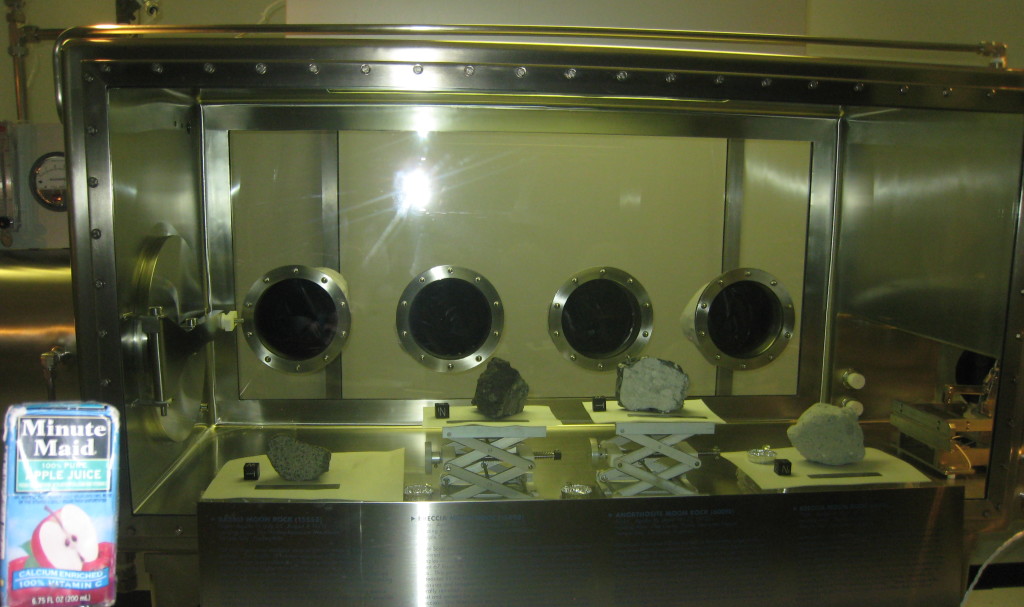
(1ST PANEL) “Basalt Moon Rock (15555) ~ Flight: Apollo 15 (July 26 – August 7, 1971) ~ Landing Area: The Hadley-Apennine Mountains ~ Sample Site: Hadley Rille ~ The first three lunar landings were within 70 miles of the Moon’s equator. The Apollo 15 mission was over 750 miles north of the lunar equator in an area called the Hadley-Apennine Mountains – a mountain range higher than the Himalayas. Rock No. 15555 is a basalt from this mountainous area, and is a medium-coarse grained igneous rock. An igneous rock is one that has formed by the cooling of molten lava. This sample’s mineral content includes brown pyroxene, yellow olivine and white plagioclase. The rock’s texture shows that is is similar to the lavas on Earth that erupt from Hawaiian and Icelandic volcanoes.” …………………(2ND PANEL) “Breccia Moon Rock (15498) ~ Flight: Apollo 15 (July 26 – August 7, 1971) ~ Landing Area: The Hadley-Apennine Mountains ~ Sample Site: Dune Crater ~ Dave Scott and James Irwin were the first astronauts to use the electric-powered lunar rover to explore the moon and collect numerous lunar samples — including this one known as No. 15498. The two men spent 67 hours on the Moon and traveled to three different geological sites. This particular rock is a breccia (brek-sha), which formed when meteorites hit the Moon’s surface about 4 billion years ago. The high pressures and temperatures that resulted from the meteorite impacts literally remelted, crushed and mixed the layers of the original lunar crust and welded the existing rocks and soils together to create breccias. This Moon rock contains glass fragments and rock minerals consisting of pyroxene, with smaller amounts of plagioclase and olivine.”

(LEFT PANEL – 60015) “Anorthosite Moon Rock (60015) ~ Flight: Apollo 16 (April 16-27, 1972) ~ Landing Area: The Cayley Plains, Descartes Region ~ Sample Site: Descartes Highlands ~ Astronauts Young and Duke landed at the western edge of the Descartes Mountains which is in the central lunar highlands, just south and right of the center of the Moon as we see it from Earth. At one point in their lunar adventure, Young exclaimed, ‘Look at those beautiful rocks….is this ever neat, Charlie.’ And Duke replied, ‘Yahoo, this is so great I can hardly believe it…’ Lunar sample No. 60015 is one of the rocks they collected. It is an anorthosite, an igneous rock formed by the slow cooling of molten lave near the lunar surface. The rock consists mostly of white plagioclase, with small amounts of olivine and pyroxene and has a black glassy coating of a different composition, probably splashed onto the rock much later by a nearby meteorite impact.”…………(RIGHT PANEL – 60016) “Breccia Moon Rock (60016) ~ Flight: Apollo 16 (April 16-27, 1972) ~ Landing Area: The Cayley Plains, Descartes Region ~ Sample Site: Descartes Highlands ~ Astronauts Young and Duke gathered an enormous collection of lunar material (approximately 213 pounds) on three different Moon walks. They spent more than 71 hours on the lunar surface, and this is one sample they brought back. This Moon rock, sample N0. 60016, is a breccia (brek-sha), like sample No. 15498, both of which formed when meteorites impacted the Moon billions of years ago. It is made up mostly of plagioclase, but has more olivine and pyroxene than the anorthosite Moon sample No. 60015. .Astronaut Young summed up the Apollo 16 mission by quoting philosopher Rene Descartes, for whom this region of the Moon was named: ‘There is nothing so far removed as to be beyond our reach or so hidden that we cannot discover it.'”

(1ST PANEL) “Looking Inside a Moon Rock ~ | Through the scientist’s experienced eyes and sophisticated instruments, Moon rocks often reveal exciting stories and help unravel some of the most important cosmic mysteries. How are the Moon and Earth allies? What can the Moon tell us about the universe? The colorful picture you see on the video monitor is an image of a razor-thin slice of a Moon rock, called a thin section, as seen through a microscope. The kaleidoscopic effect is created by slowly rotating the thin section under the microscope in polarized light. The rock slice acts like a prism separating the polarized white light into colors according to the different crystalline properties of minerals.”….(2ND PANEL) “A Microscopic Look ~ For viewing rocks under the microscope, chips from them are cemented to glass slides and then ground down and polished to paper thinness. Once a Moon rock slice is thin enough, light can pass through it. When viewed under a microscope, the type and texture of minerals can be studied and the Moon rock’s history analyzed. There are more than 5,000 thin sections of Moon rocks now being studied in laboratories around the world.”…..(3RD PANEL) “Thin Section from Moon Rock No. 15555 ~ The thin section image viewed here was taken from the Apollo 15 basalt displayed in the cabinet containing the four large Moon rocks. In this thin section, the plagioclase appears gray and the ilmenite, black. The pyroxene and olivine are the brightly colored minerals. In plain light, the minerals would simply appear white, black and gray with the subtle shades of brown or green.”

(1ST PANEL) “Understanding Lunar Soil ~ From the moment Galileo looked at the Moon through the first telescope to the moment Apollo 11 astronauts Neil Armstrong and Buzz Aldrin walked on lunar soil, a great deal had been learned about Earth’s only satellite. Using Earth telescopes, scientists could recognize numerous craters, rugged mountain ranges and deep winding canyons of the Moon. But throughout the Apollo explorations, a wealth of information about the Moon’s composition brought us to a new era of discovery. We have learned that the various lunar landscapes are covered by a layer of fine, broken-up powder and rubble about 3 to 60 feet deep. This layer is called ‘lunar soil’. Lunar soil is especially unique to us because it contains no water or organic material, could only have been formed on the surface of an airless world and is quite different from soil found on Earth. Over billions of years, lunar soil has been built up by continual bombardment of large and small meteorites — meteorites that would have burned up had they entered the Earth’s atmosphere.” …….(2ND PANEL) see image below………………….(3RD PANEL) “The Composition of Lunar Soil ~ This is an actual stainless steel case used by Apollo astronauts to collect and return lunar soil to Earth. While on the Moon, the astronauts gathered pieces from boulders and picked up loose rocks. Most of the samples which were scooped up and bagged, however, were sand-sized and smaller rock fragments defined as lunar soil . These charts identify the minerals and elements of Apollo 11 soil samples No. 10084 brought back by Armstrong and Aldrin. Lunar rocks and soils are made up largely of the minerals pyroxene and plagioclase. The mineral ilmenite makes up about 14% of lunar soil. It has been determined that hydrogen gas can react with ilmenite to produce water. It also has been discovered that lunar soil is made up of approximately 42% oxygen by weight, and technology is now being used to extract the important element of oxygen from lunar soil. Scientists are discovering ways to add essential nutrients to the lunar soil returned during the Apollo program so that a variety of plants can be grown in controlled environments.”……………….(4th PANEL) see image below
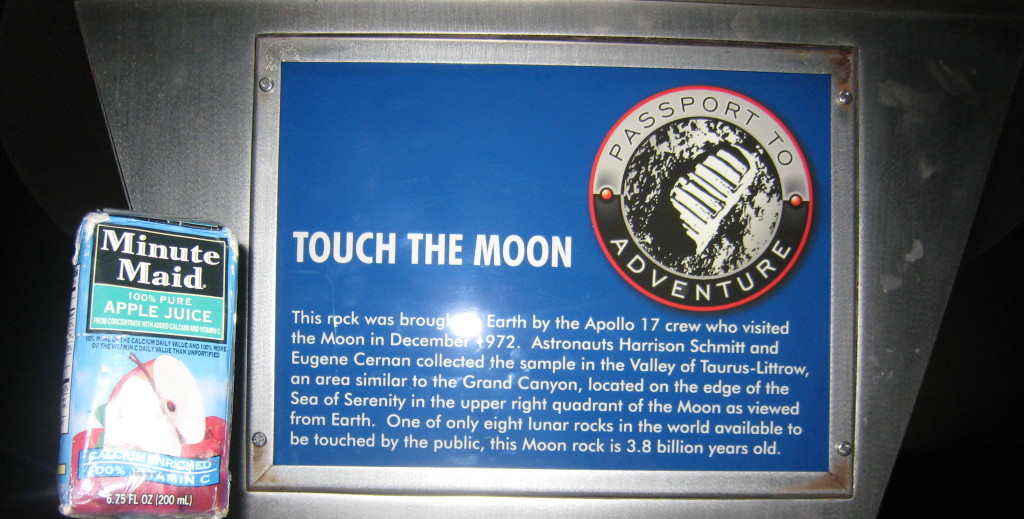
“Touch the Moon ~ This rock was brought to Earth by the Apollo 17 crew who visited the Moon in December 1972. Astronauts Harrison Schmitt and Eugene Cernan collected the sample in the Valley of Taurus-Littrow, an area similar to the Grand Canyon, located on the edge of the Sea of Serenity in the upper right quadrant of the Moon as viewed from Earth. One of only eight lunar rocks in the world available to be touched by the public, this Moon rock is 3.8 billion years old.”

“Mission Control Console ~ In Mission Control, some of the most brilliant minds in America worked with the most advanced technology in the world. Consoles, like this one, functioned as the critical junction between man and machine. When Mission Control opened in Houston in March of 1965, it was the most powerful computing complex the world has even seen. Ironically, most of the actual mission’s computing was not done by the computers, but by the ground controllers in Mission Control. The computers simply relayed information from the spacecraft to a controller’s console. Sometimes the computer would notify a controller of a situation with an ‘event light’ which was hard wired to light up for a specific event. If controllers wanted to change an even lights function, it would require months of rewiring hardware. This console was removed after the new Flight Control Room became fully operational in 1997.”
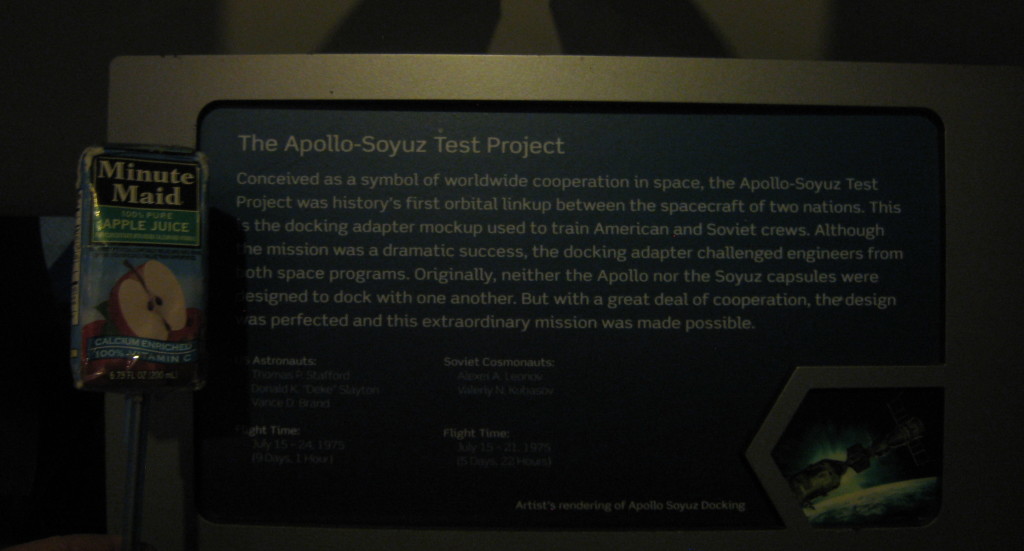
“The Apollo-Soyuz Test Project ~ Conceived as a symbol of worldwide cooperation in space, the Apollo-Soyuz test Project was history’s first orbital linkup between the spacecraft of two nations. This is the docking adapter mockup used to train American and Soviet crews. Although the mission was a dramatic success, the docking adapter challenged engineers from both space programs. Originally, neither the Apollo nor the Soyuz capsules were designed to dock with one another. But with a great deal of cooperation, the design was perfected and this extraordinary mission was made possible.”

“The Potential of Helium-3 ~ Finding adequate energy resources for the people of Earth will be a continuing challenge in the future. Amazingly, the Moon may provide us with just the energy source we need in the next century. Analysis of Apollo lunar samples has shown that Helium-3, an isotope that is very rare on Earth, exists in abundance on the lunar surface and was deposited there over billions of years by output from the Sun. Studies have shown that Helium-3 (containing 10 times the Earth’s existing fossil fuel energy), could be a very attractive fuel for 21st Century thermonuclear fusion reactors. Unlike the fission reactors of today, fusion technology could provide virtually unlimited power without producing long-lived, highly radioactive wast products for the Earth, as well as generating power for space stations, lunar settlements, bases on Mars and spacecraft exploring the far reaches of the Solar System. The cargo bay of one Space Shuttle could hold enough fuel needed to provide the U.S. with electricity for one year.”

“Skylab – America’s First Space Station ~ This is the actual trainer used by astronauts to train for life aboard Skylab, the first American space station. After the Mercury, Gemini and Apollo programs, Skylab was designed to develop methods of living and working in space for long periods of time. It also functioned as the first telescope in space and served as a laboratory to study how the human body adapts to long duration exposure to a microgravity environment. The space station was created by converting the final stage of a Saturn V moon rocket into a habitable spacecraft and lining it with experiments and equipment. The Skylab crews had plenty of room. The space inside was about 12,500 cubic feet, about the same size as a three bedroom house and almost as comfortable. Crews had individual bunks, a ward room, personal libraries and even a shower! Three crews spent a total of 171 days onboard Skylab and conducted a wide array of research.”

“Skylab Airlock Module ~ A total of eleven space walks were performed by the three Skylab crews. This Airlock Module (AM) allowed them to make brief excursions outside to perform experiment support or station maintenance. The airlock was completely sealed by closing air tight hatches that led into the rest of the space station. Once the air was evacuated, the suited astronaut would open the Gemini style hatch to begin the space walk. Outside, the astronaut would use a series of blue handrails to transition to the worksite. The spherical and cylindrical storage tanks mounted on the external truss work of the AM provided oxygen and nitrogen needed for Skylab’s life support system. The AM was also the ‘nerve center’ of Skylab, serving as the home to electrical power control, data handling and recording equipment, environmental control systems and communications. A total of eleven space walks were performed by the three Skylab crews.”
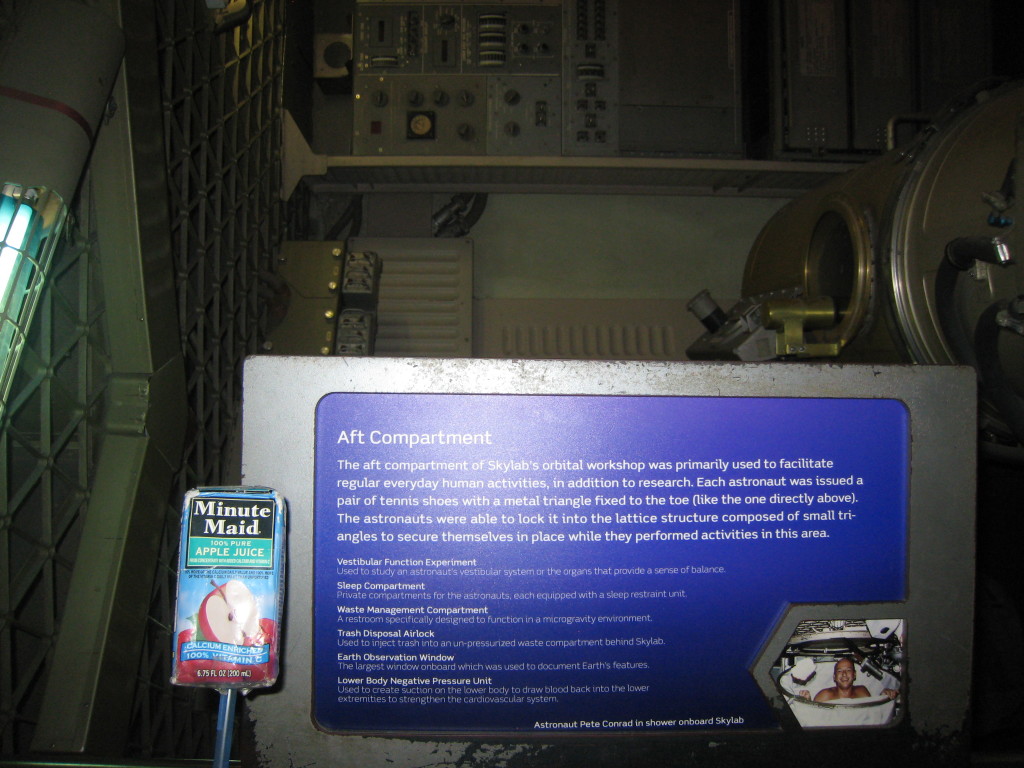
“Aft Compartment ~ The aft compartment of Skylab’s orbital workshop was primarily used to facilitate regular everyday human activities, in addition to research. Each astronaut was issued a pair of tennis shoes with a metal triangle fixed to the toe (like the one directly above). The astronauts were able to lock it into the lattice structure composed of small triangles to secure themselves in place while they performed activities in this area.”

“Robonaut is a humanoid robot that is designed to assist or replace an astronaut conducting a space walk. Setting up a worksite can consume up to one third of the time an astronaut spends on an EVA (Extra vehicular activity). Robonaut can assist astronauts by performing these duties before the astronaut has finished putting their suit on. Robonaut is designed to be operated from a distance using telepresence. The operator receives visual information from cameras mounted in Robonaut’s helmet. The visual information is transferred to a head mounted display on the operator who controls Robonaut by moving his head and hands. Robonaut’s hands are designed to work with tools that are already in use by astronauts. The design of the hand includes four fingers and an opposable thumb, so it can interact with tools just like a suited astronaut.”

“The Space Shuttle ~ For the first 24 years of the Space Age, journeys into orbit depended on launch vehicles that were used once and then discarded. All of this changed in 1981 with the advent of the American Space Shuttle Program – the world’s first reusable spacecraft. The Shuttle consists of three main elements. The Orbiter is the airplane-shaped vehicle that carries crew and payloads into space. The External Tank carries more than 500,000 gallons of liquid hydrogen and liquid oxygen which is consumed in the first eight and one-half minutes of flight. The twin Solid Rocket Boosters burn solid fuel, burn out about two minutes into flight and parachute into the Atlantic where they are recovered and towed to shore for reuse. NASA’s fleet of three orbiters, Discovery, Atlantis, and Endeavour, studies the Earth, carries a variety of payloads into orbit, enables engineers to gain information about space travel and provides the United States with routine access to space.”

“Astromast ~ The AstroMast suspended above is a prototype used to develop a solar array deployment mechanism called the Solar Array Flight Experiment (SAFE). The accordion like design of the truss structure allows the entire length of the AstroMast to fold up and stow in the container at the base. When fully extended, the truss is an extremely ridged structure. SAFE was tested on STS-41D in 1984 to evaluate its possible use as a power source during extended shuttle missions and on future space stations. The solar cells, stacking a mere three inches (7.6 centimeters) high when stored, stretched out over 100 feet (30.5 meters) when unfolded by the AstroMast. This SAFE prototype led to the current solar array deployment mechanism used on the International Space Station and has been used on multiple robotic spacecraft.”





